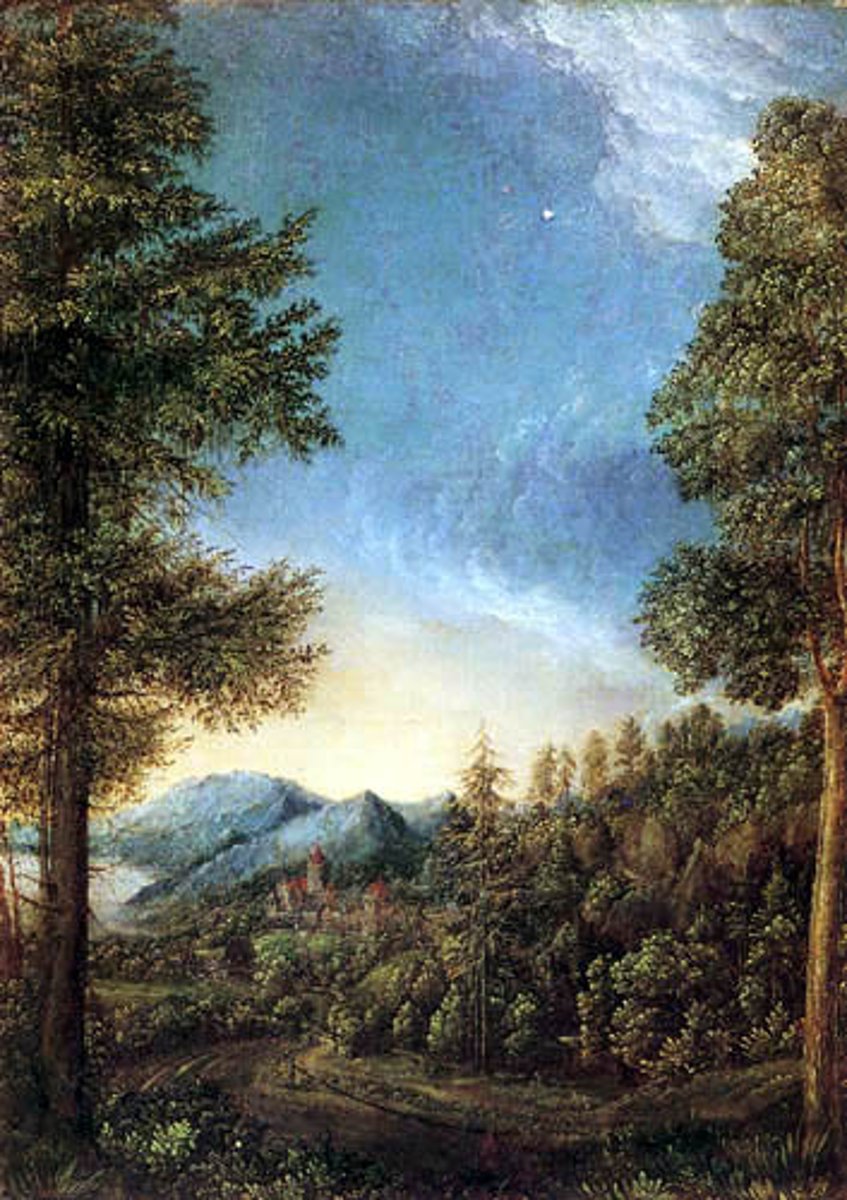Civilization and the Arts- Munson Exam 1
1/99
There's no tags or description
Looks like no tags are added yet.
Name | Mastery | Learn | Test | Matching | Spaced |
|---|
No study sessions yet.
100 Terms
Greek
Greek
Archaic, Classical, Hellenistic periods corresponding with different orders and modes of representation
Archaic-traditional, Doric
Classical- objective/idealistic, Doric/Ionic
Hellenistic- subjective, Corinthian
Dipylon Amphora
750 BC
5 ft tall, traditional, geometric patterns, "the mourning of the dead", symmetrical
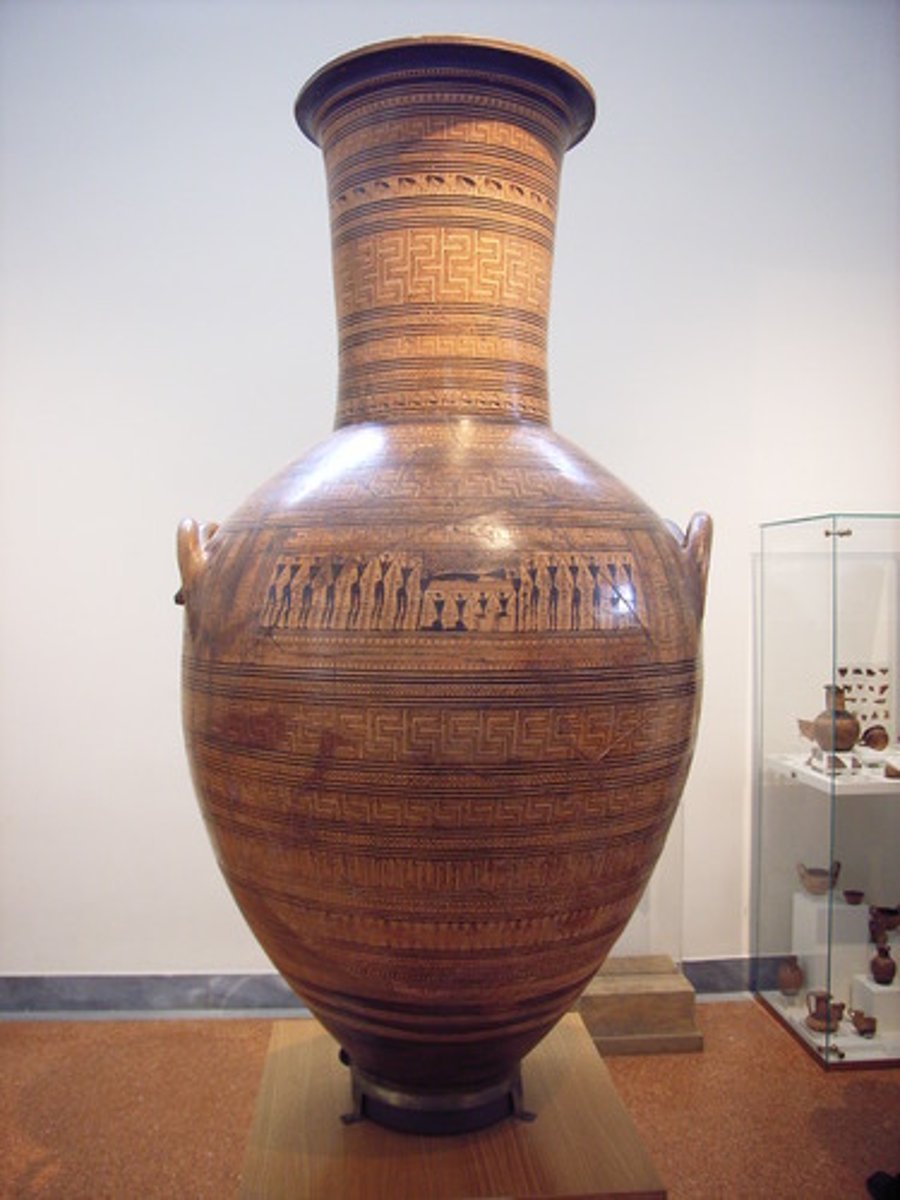
Achilles and Ajax Playing a Dice Game
Exekias, 540 BC
2 ft tall, traditional, Achilles's hidden heel, hierarchy of helmets
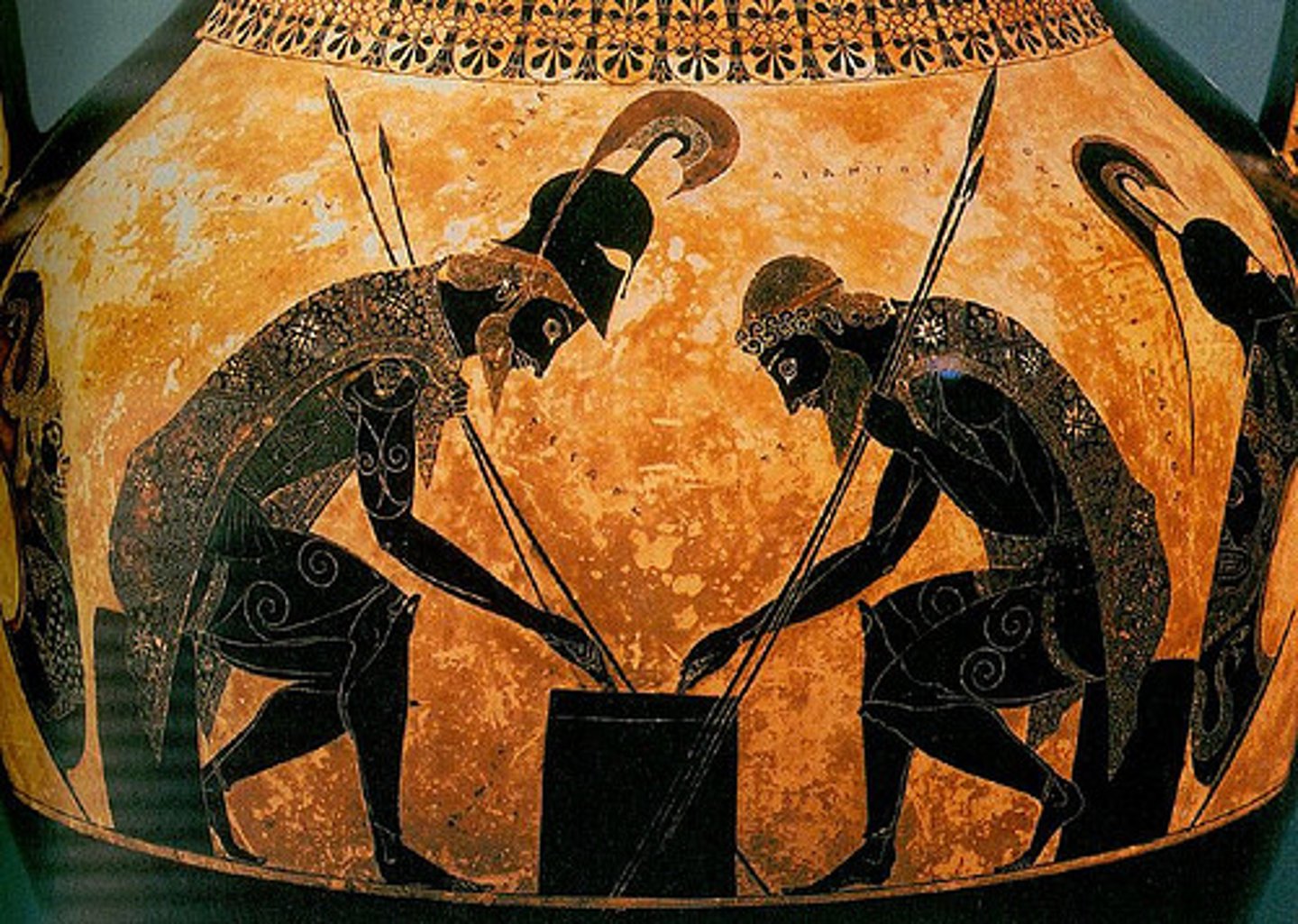
The Warrior's Leave-Taking
Euthymedes, 510-500 BC
almost classical (foot facing forward for perspective), negative space, Hector of Troy with Priam and Hecuba, very breast of life sends him to his death
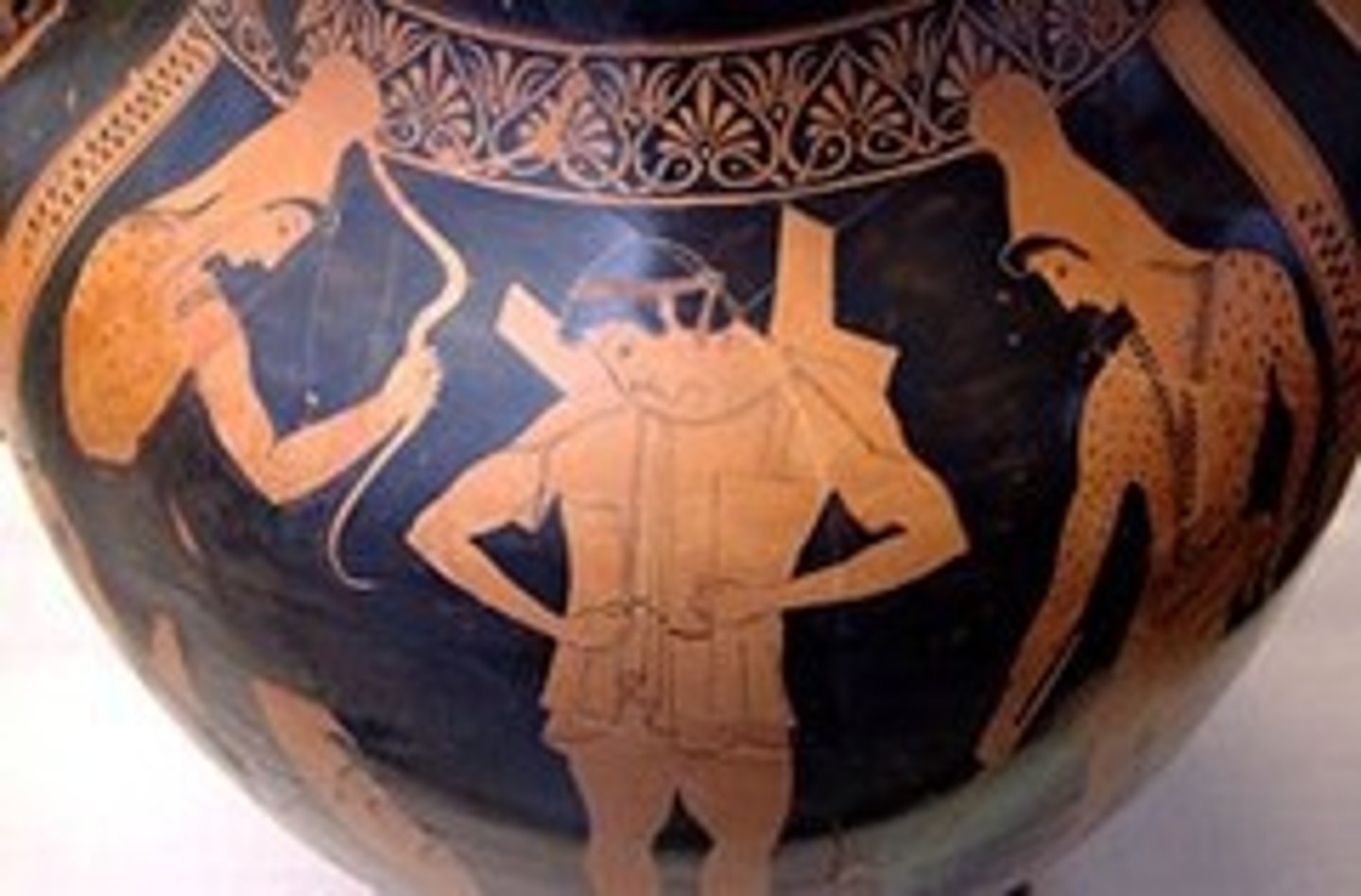
Ulysses Recognized by His Old Nurse
480 BC
classical, expressing human interaction
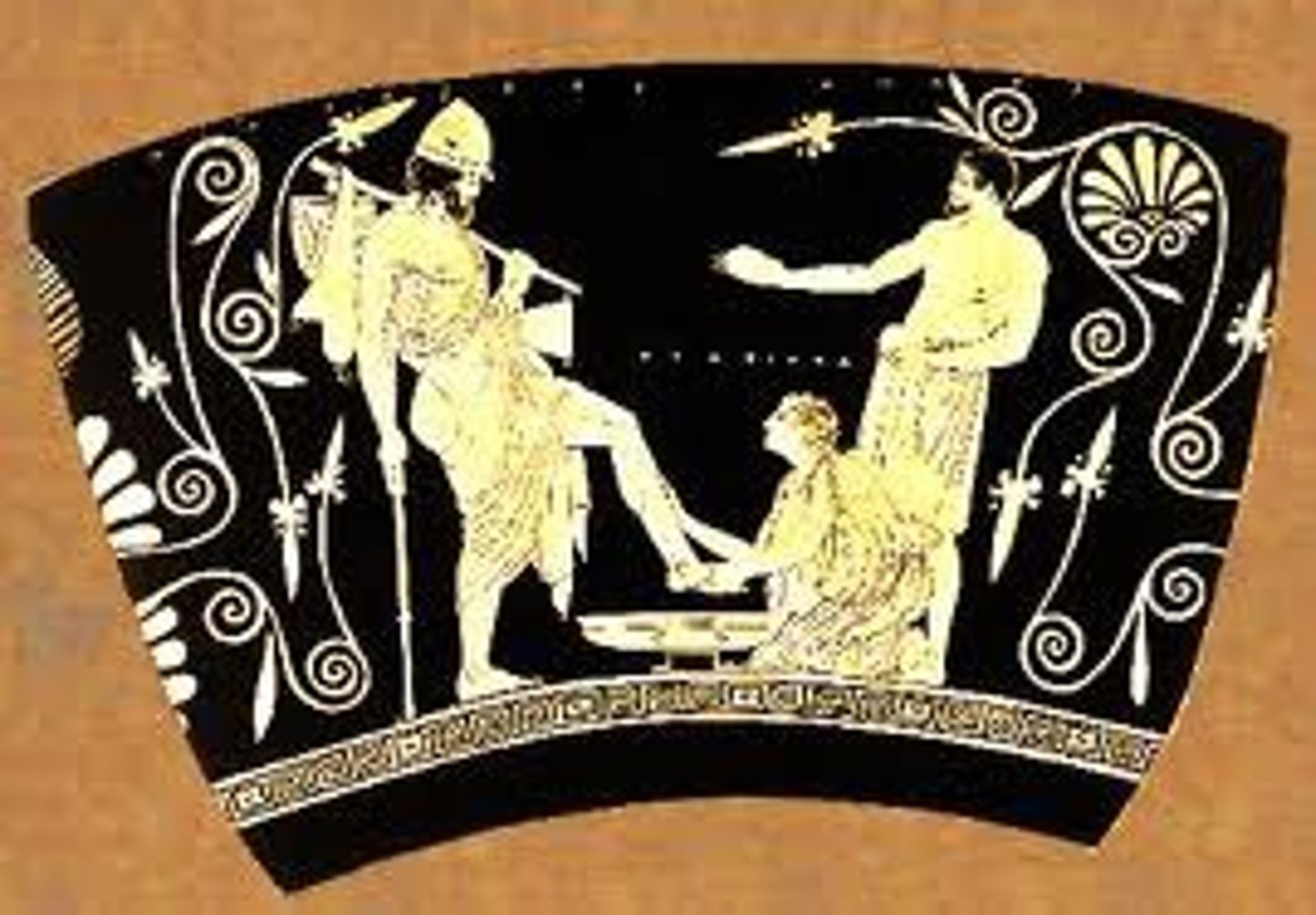
The Brothers Cleobis and Biton
Polymedes of Argos, 615-590 BC
traditional, "the boy" type, human figure exposed (new by Greeks), unconstrainted by realism
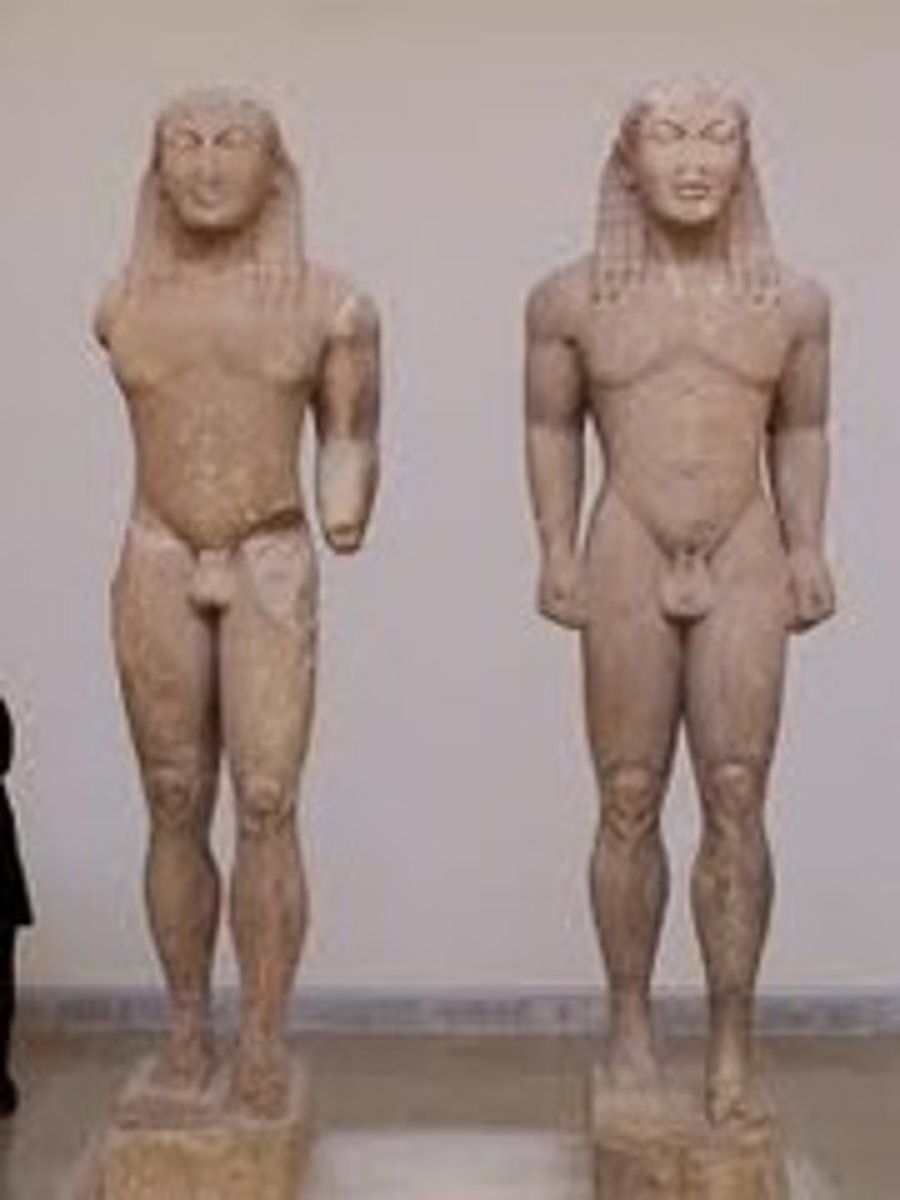
Kritios Boy
490 BC
relaxed figure, CONTRAPPOSTO, first purely objective sculpture

Diskobolos (Discus Thrower)
Myron, 450 BC
Roman marble copy of the bronze original (copy of a copy of a copy...), no one able to do it like Myron, ideal/embodiment of "athleticism", at greatest potential energy to be released

proportions of Diskobolos
-discus is a PERFECT CIRCLE
-hand to hand make a semicircle, split in halves by the head
-large semicircle from disc/hand to feet, cut into thirds by the torso and legs
3 orders of Greek Architecture
Doric, Ionic, Corinthian
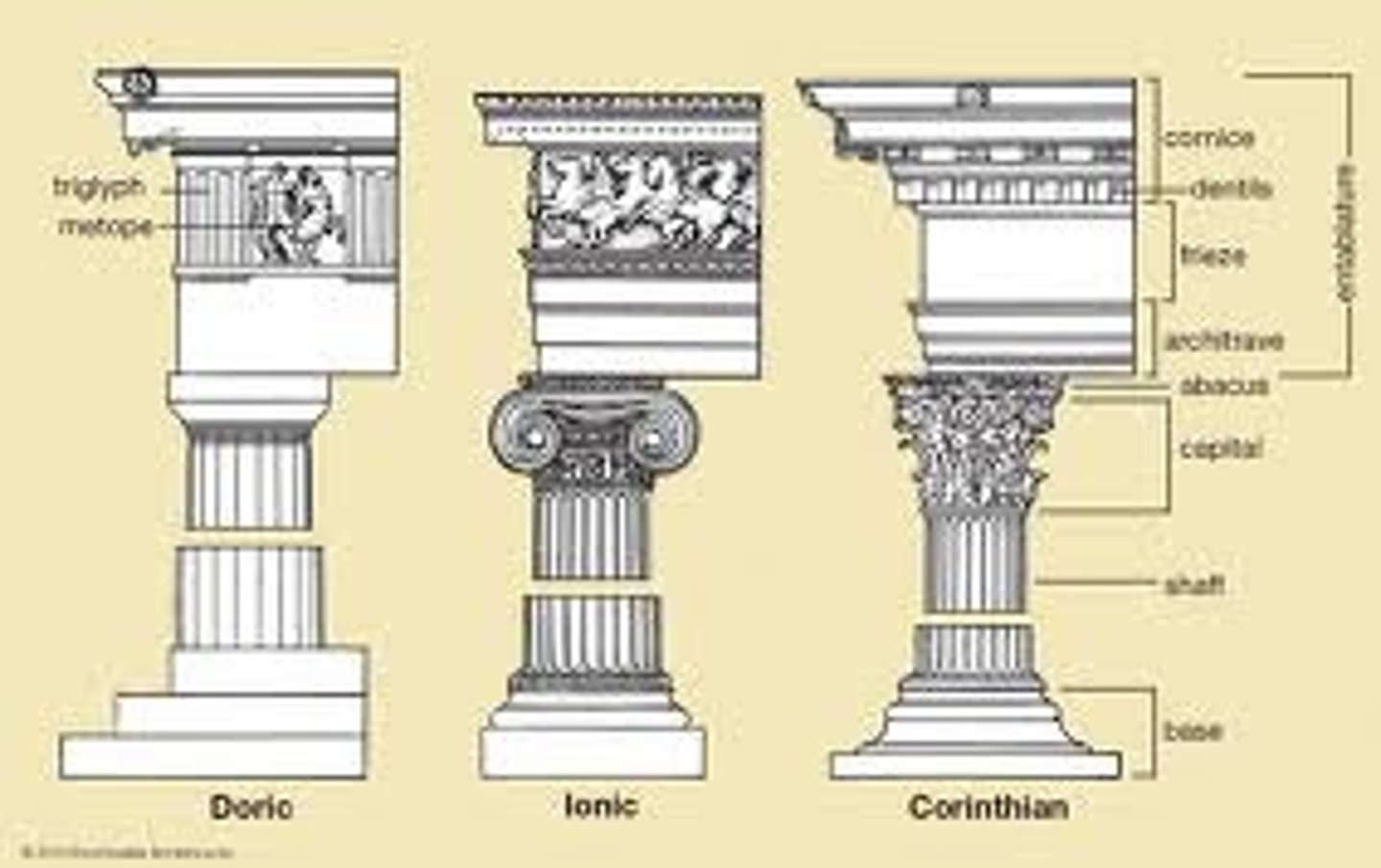
Doric Order
the simplest of the classical Greek architectural styles, featuring unadorned columns with no official base, bottom of column was thicker than the top, vertical grooves are widest of the orders, bulge 1/3 the way up is noticeable to the naked eye (like tree bearing weight), top of lintel is decorated with "low relief" sculpture on the frieze, outside (not inside) is the focus
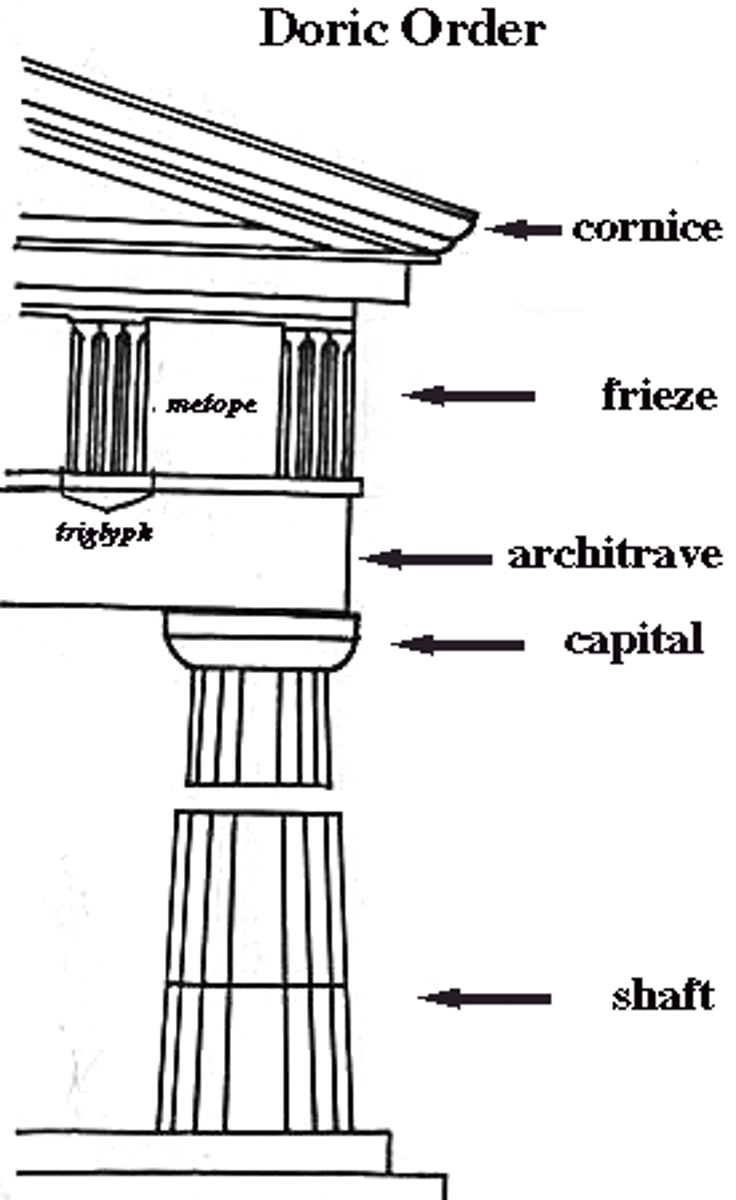
Ionic Order
classical Greek architectural style that features a fluted column shaft, capitals with volutes (spiral scroll-like ornaments) and a large base, more slender, bulge 1/3 of the way up is not noticeable, no metope squares (unbroken and no panels), large-scale high relief sculpture on pediment
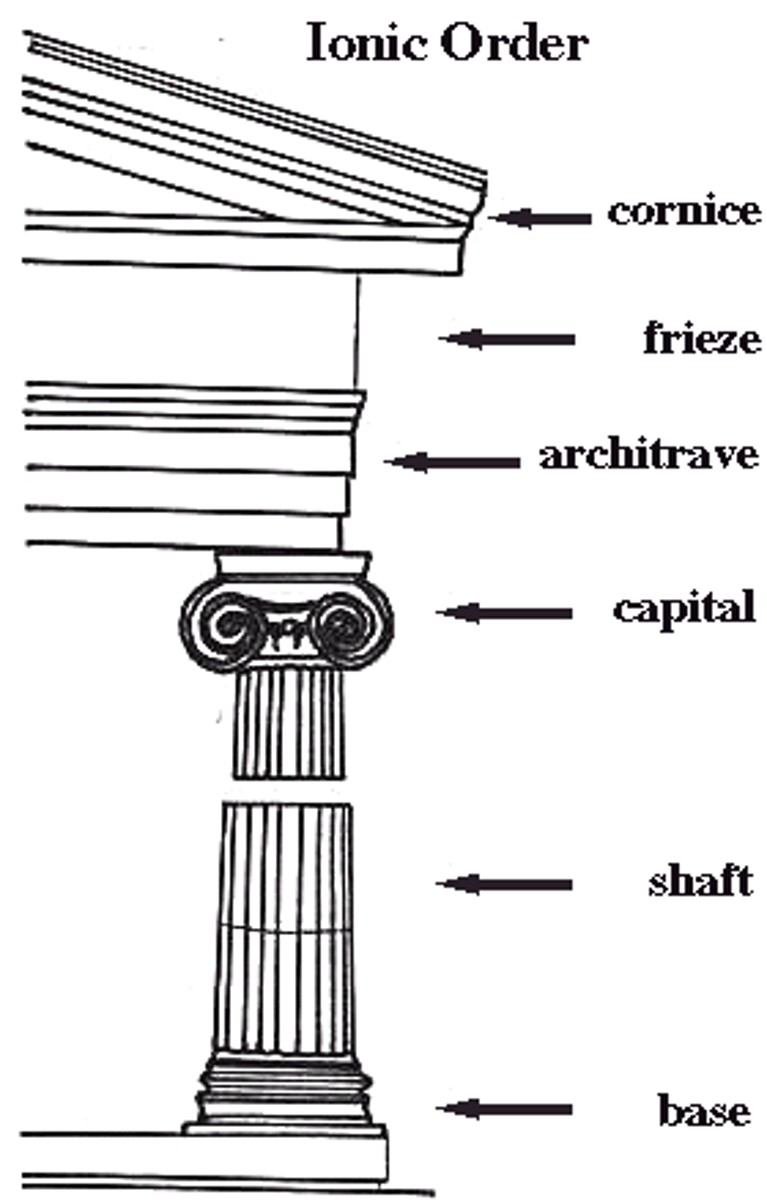
Corinthian Order
the most decorative of the classical Greek architectural styles, featuring a fluted column shaft, capitals with flowers and leaves below a small scroll, and a large base (used more by the Romans), mark of the Hellenistic period
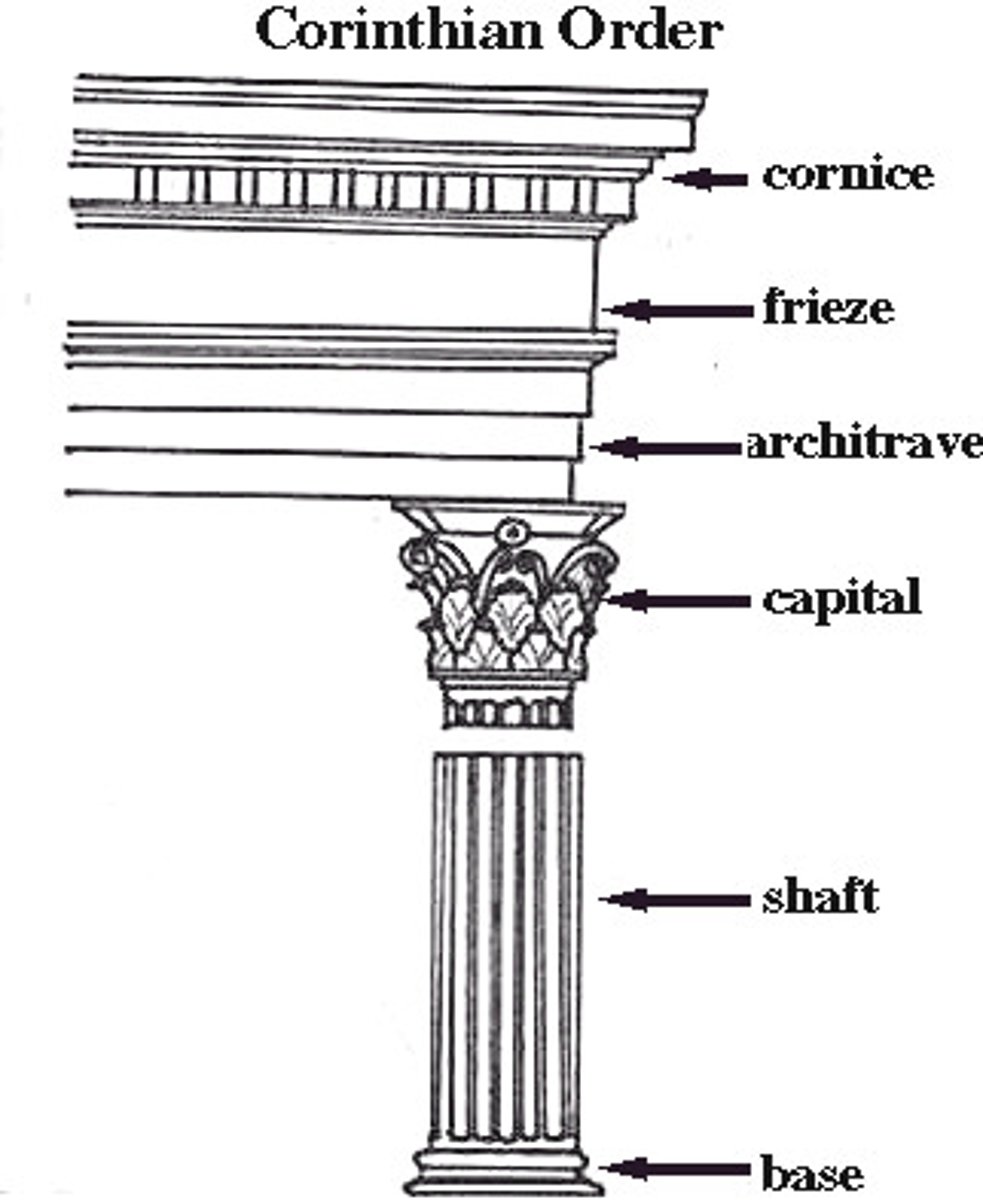
pediment
the triangular top of a temple that contains sculpture

low relief sculpture
sculpture projections are relatively small from the background
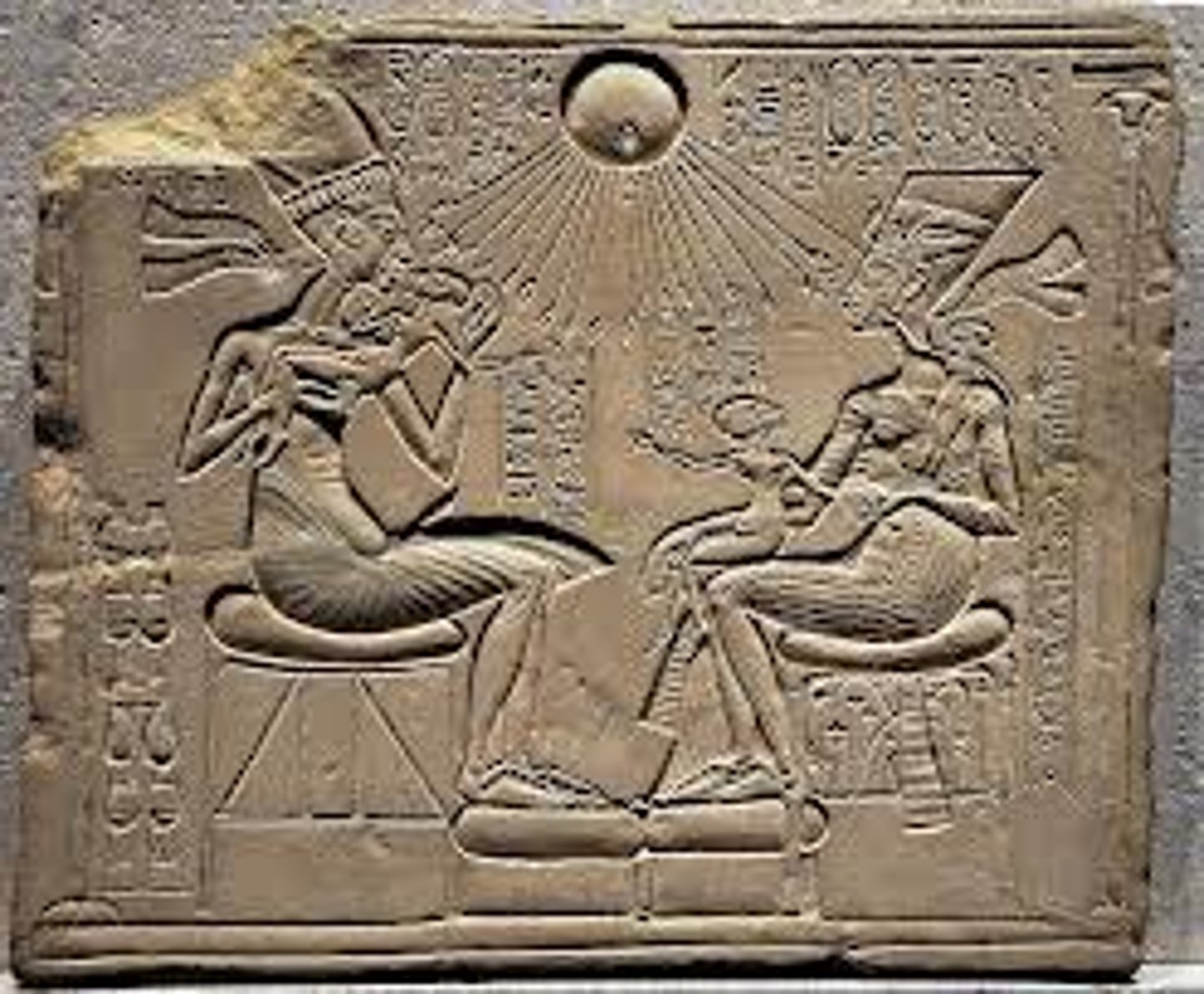
high relief sculpture
Sculptures that emerge far from the background
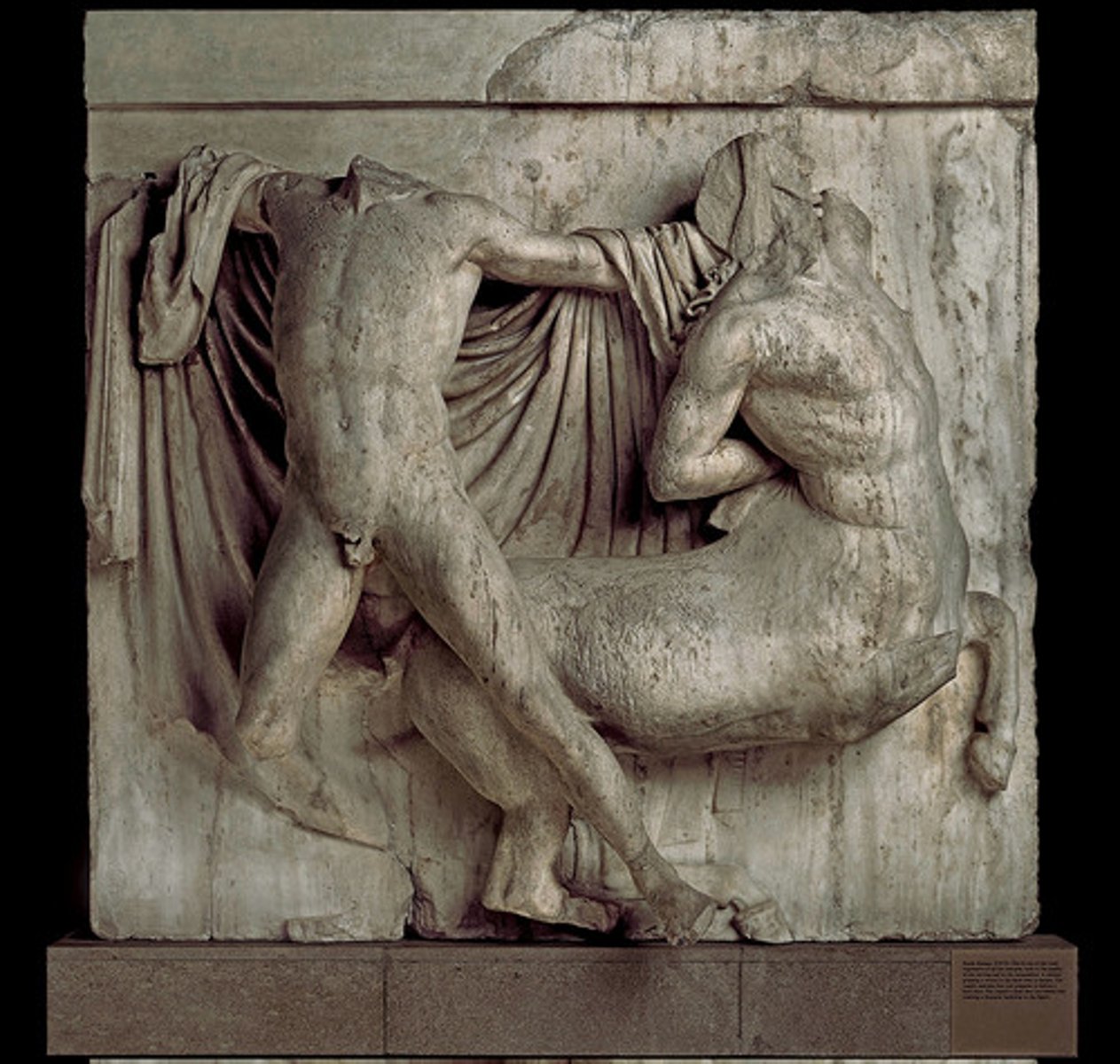
Temple of Zeus at Olympia
470-456 BC
1:2 proportions, most incredible Doric temple (likely better than the Parthenon), broken and in ruins
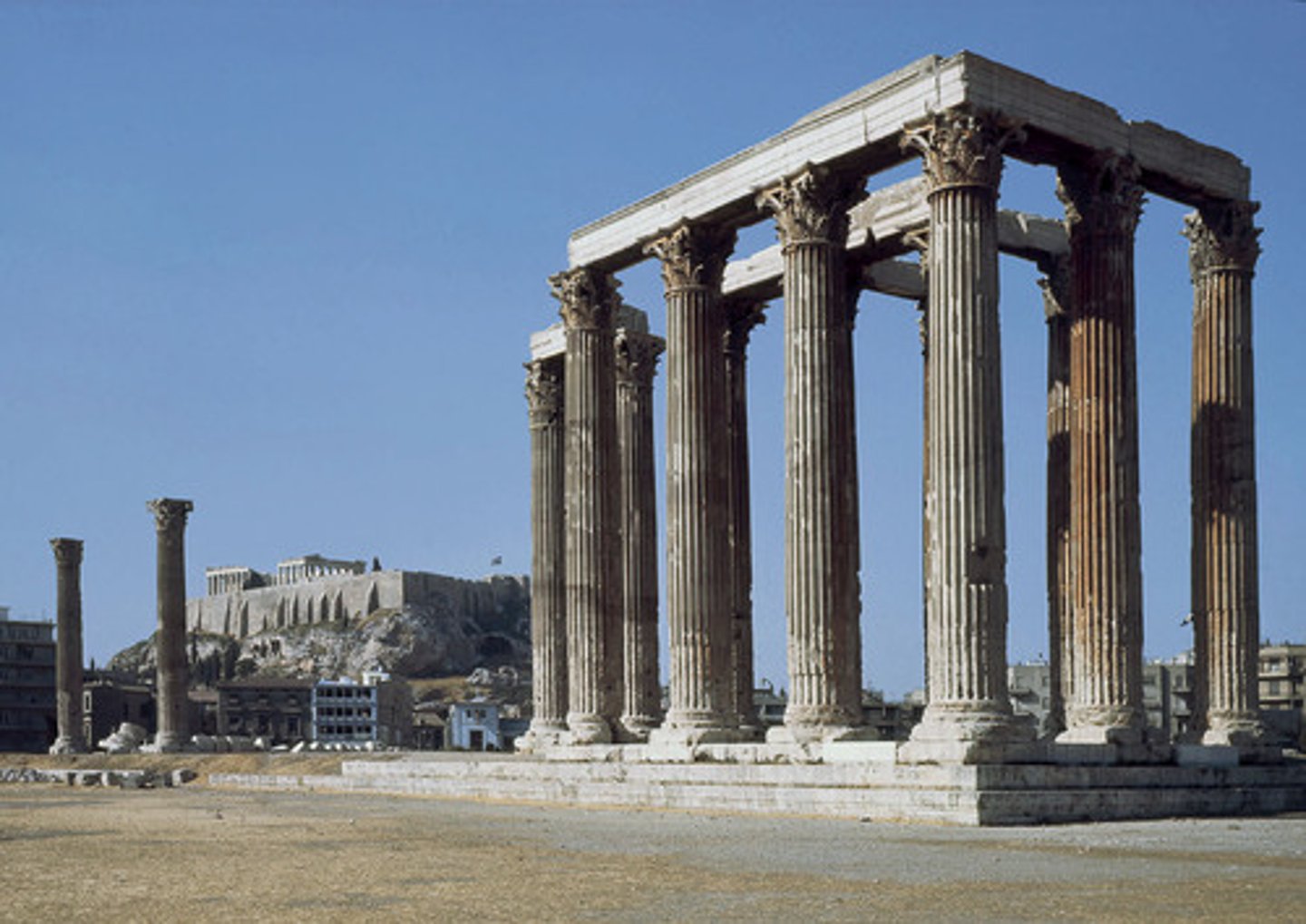
Hercules Carrying the Heavens
carved under Pheidias, 470-460 BC
Marble Metope from the Temple of Zeus at Olympia, Atlas gets apples for Hercules while he holds up the heavens, Athena helps, order and symmetry in how the male faces and divine faces mirror eachother
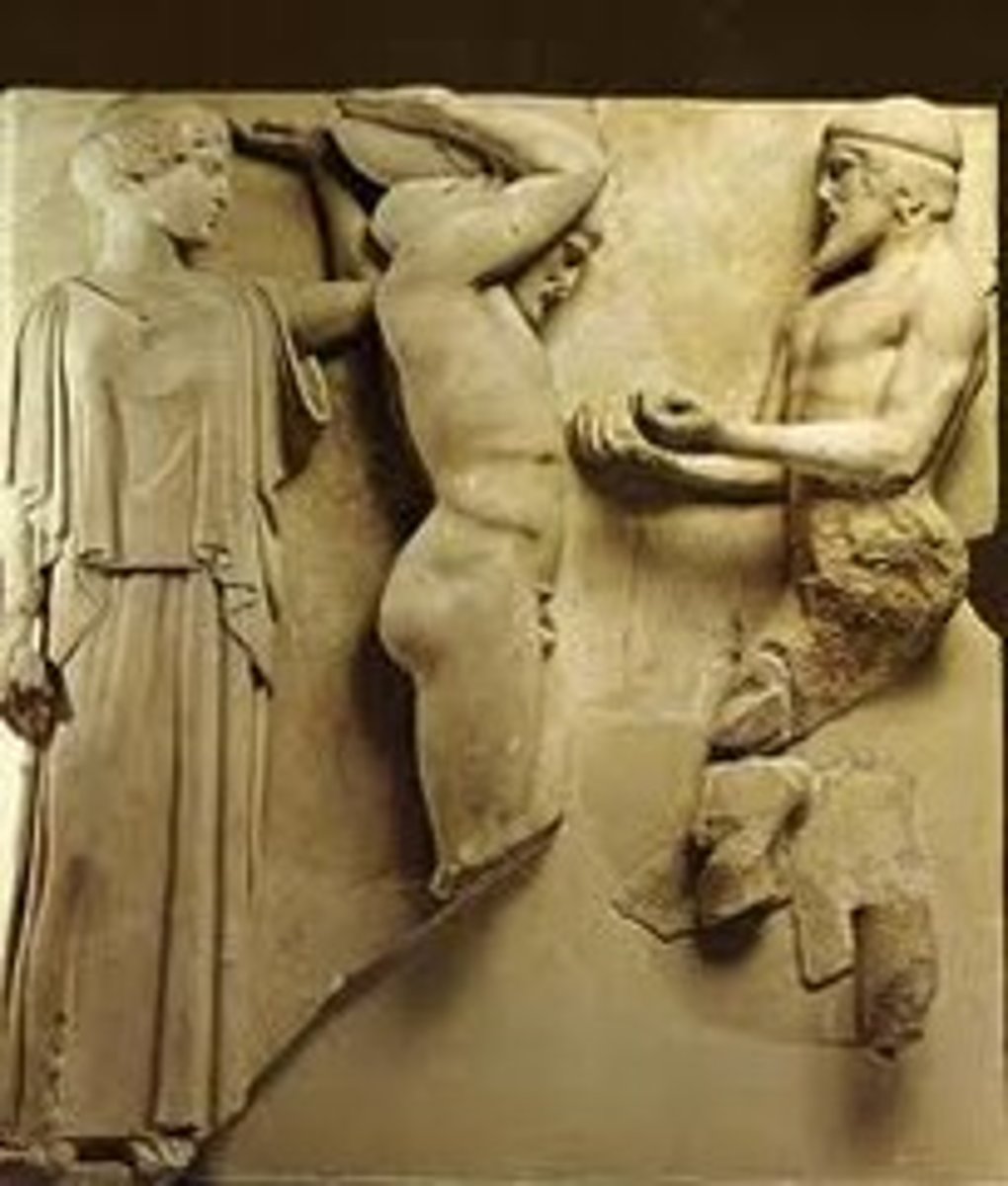
Temple of Athena Nike
427-424 BC
at Acropolis/Athens, example of Ionic
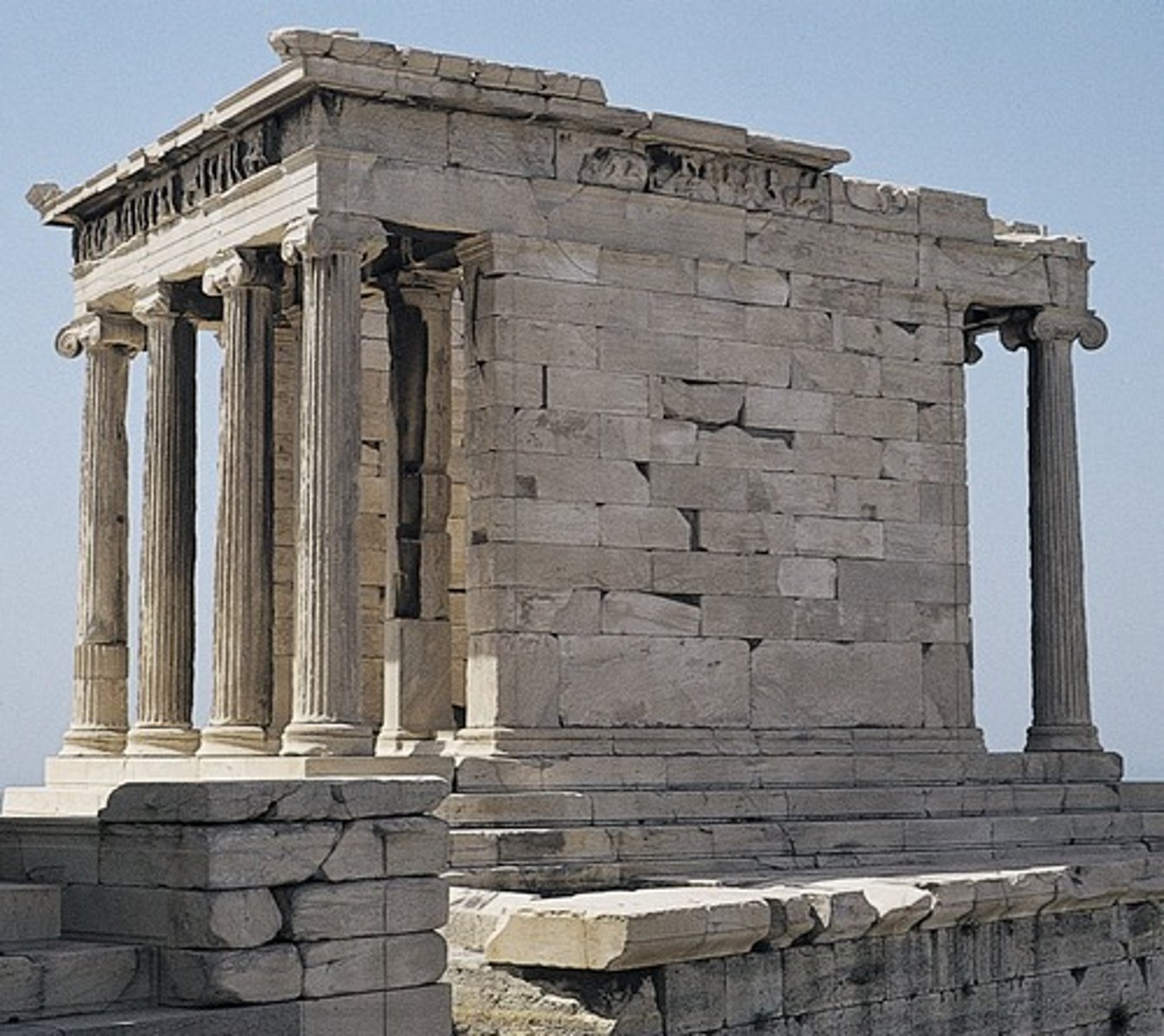
Parthenon
447-432 BC
at Acropolis/Athens, 46 Doric columns, transportation of 13 ton capitals=most expensive, shaped and finished at the marble quarry, no mortar/pins,
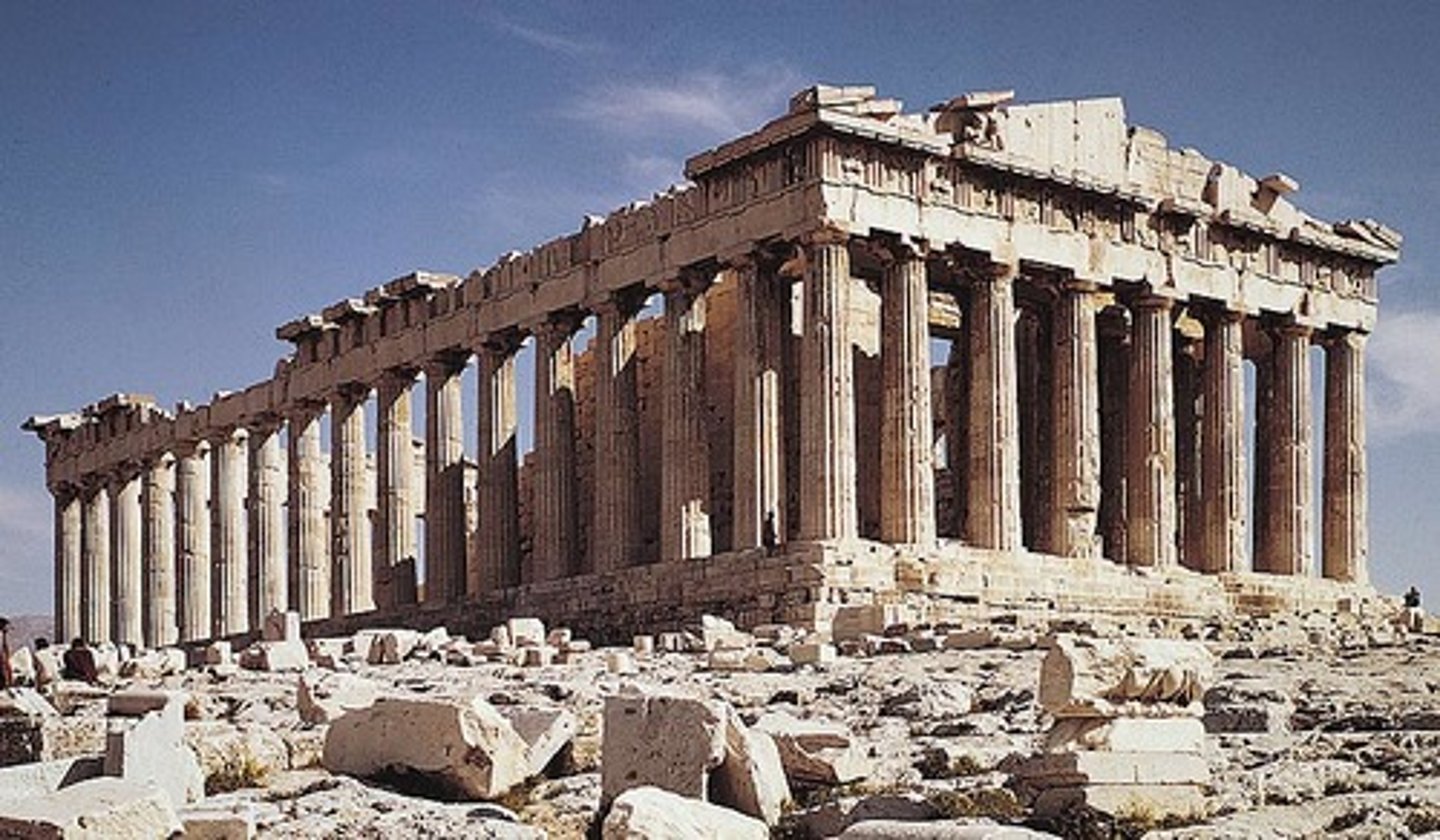
Formula for the Parthenon
x=2y+1, rejects Polycleitus's perfect proportions (x=2y)
Does the Parthenon have any flat surfaces?
NO. curved floor, curved lintels, closer spaced columns toward the corners to appear symmetrical against the blue sky, all columns curve inward (to resist earthquakes), lintels lean out so easy to see the sculpture
Where is the roof sculpture?
History of the Acropolis/Parthenon: became Athena's temple into a Christian Church to Mary into a Roman Catholic Church into a Mosque for the Turks...Phoenician siege of Athens in the 1600s leads to the bombing of the Parthenon because it was being used as an armory. Some random guy started selling the broken high relief sculpture in the 1830s and many parts are still in the British Museum
Erectheion
420-405 BC
at Acropolis/Athens, Ionian temple (1 of 4 on Acropolis), posts carved into the shapes of priestesses (south side), ionic posts hold up "weightless" tops (north side)
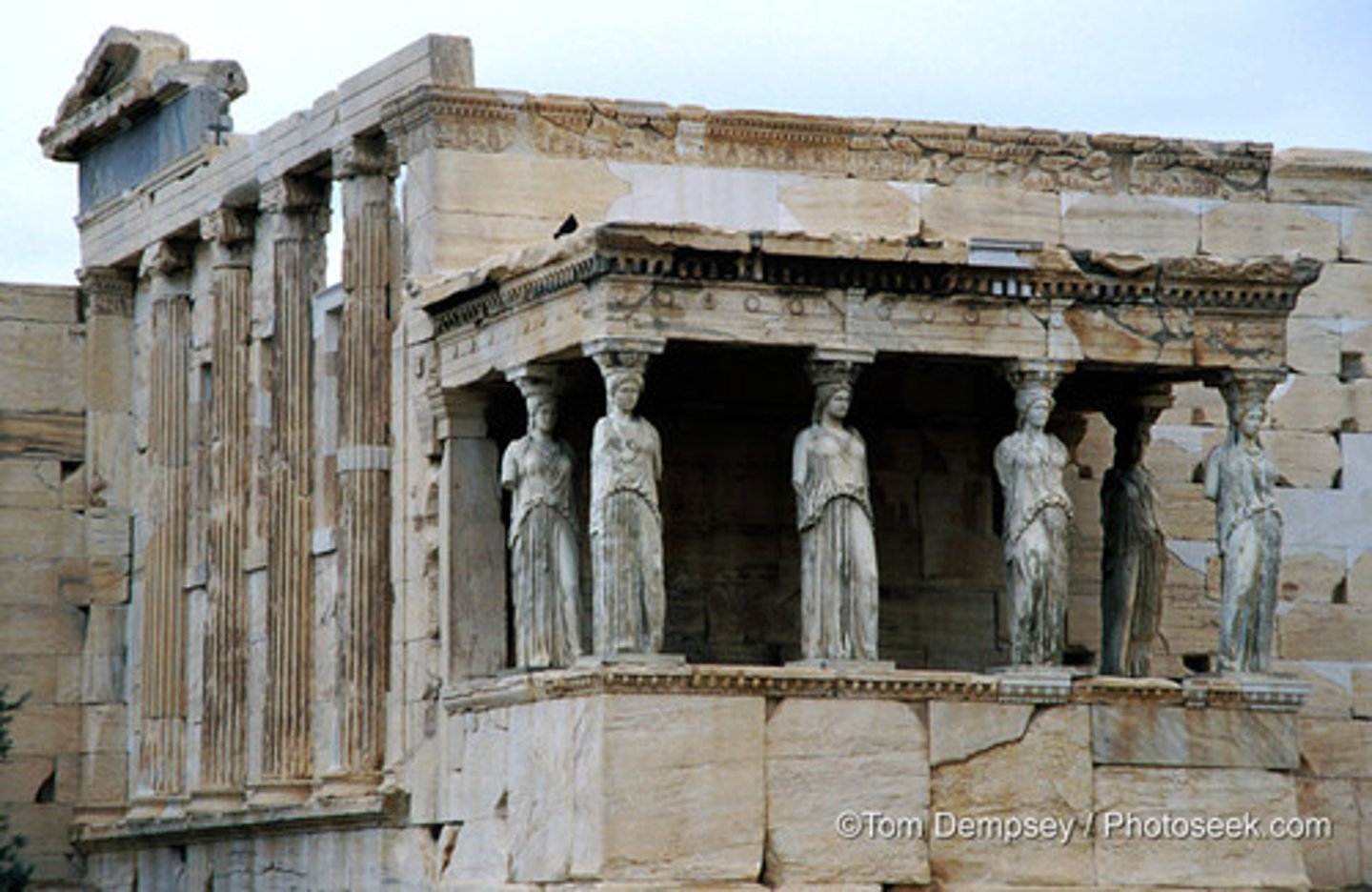
Hellenism
Hellenism
Hermes with the infant Dionysus
Praxiteles, 340 BC
at Olympia, from Temple of Hera, likely a copy, Hermes= messenger trickster god, Dionysus= party and wine god, relaxed CONTRAPPOSTO, idealistic perfect form of man, Hermes teases Dionysus with grapes (NOT classical)
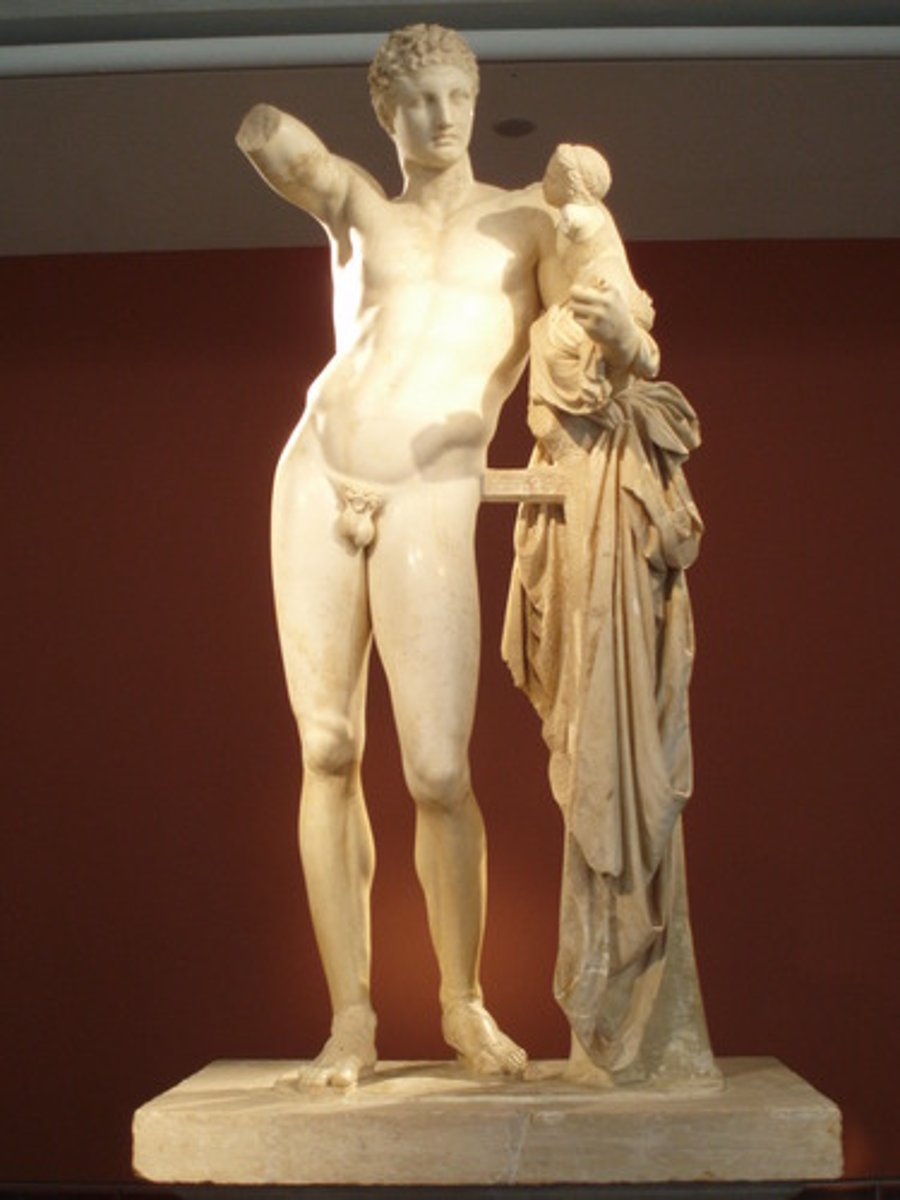
Laocoon and His Sons
175-50 BC
made at Rhoades, Laocoon warned against the Trojan horse and Poseidon sends sea monsters, supposed to be dramatic, scale/proportions are wrong (Laocoon vs. sons, and sons bodily looking like men)
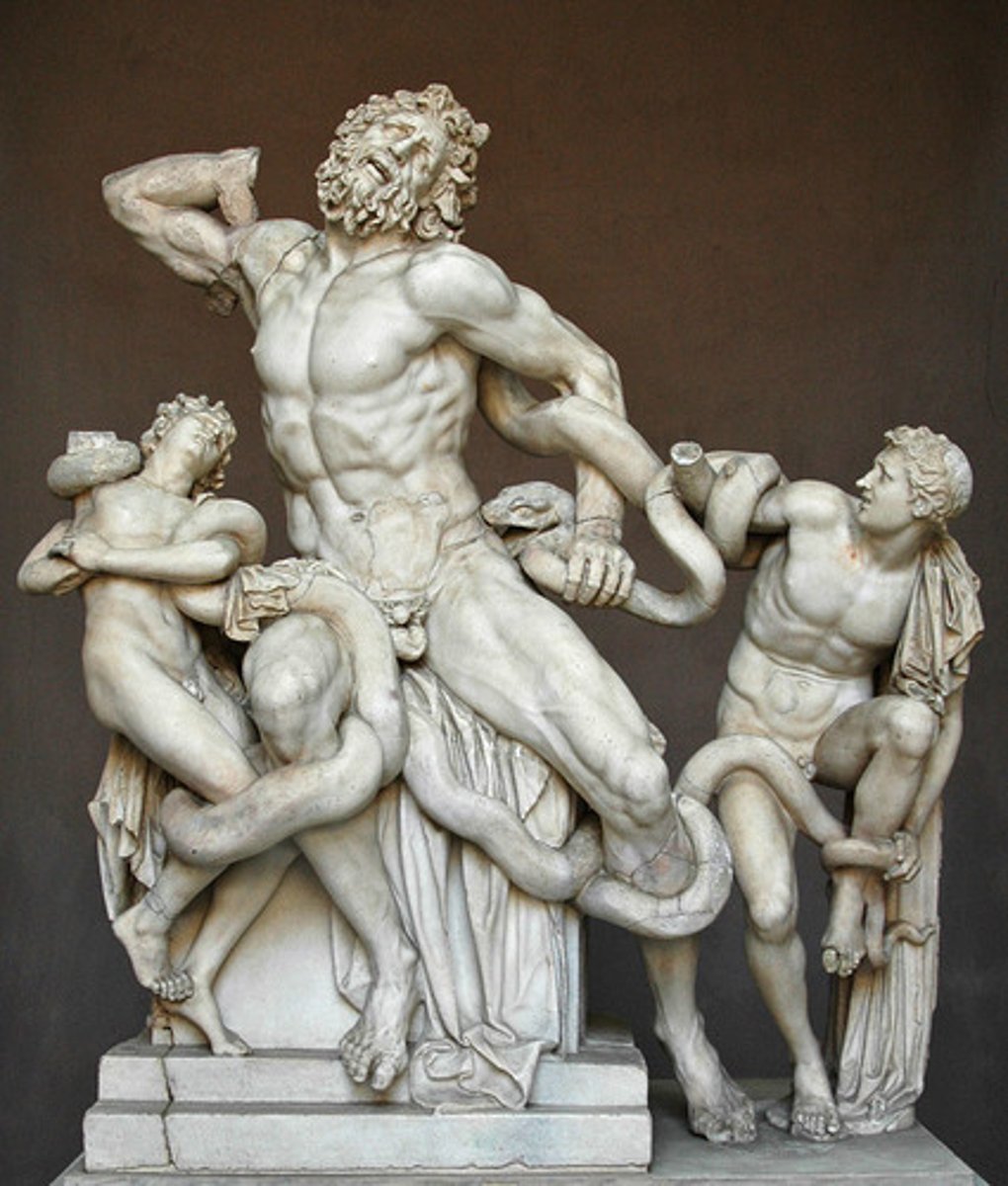
Roman (509 BC-476 AD)
Roman (509 BC-476 AD)
Founding of the Roman Empire?
Transmission from the Republic to Empire?
Fall of the Western Roman Empire?
509 BC
27 BC
476 AD
Colosseum
70-80 AD
Ionic, Doric, Corinthian columns, represents Greek ideas in a Roman way by including ALL of them (ULTRA-INCLUSIVE)
Pantheon
126 AD
altars to ALL (pan-) THE GODS (-theon), perfect 3D circle (as wide as it is high), hole at the top embodies the solar system movements, can't tolerate Christianity in the ALL the GODS temple
Monastic/Byzantine period
Monastic/Byzantine period
saved art
basilica
based on the temple models, leads to cathedrals

basilica structure
know aisle (lower ceiling), nave (higher ceiling), apse, transepts, columns
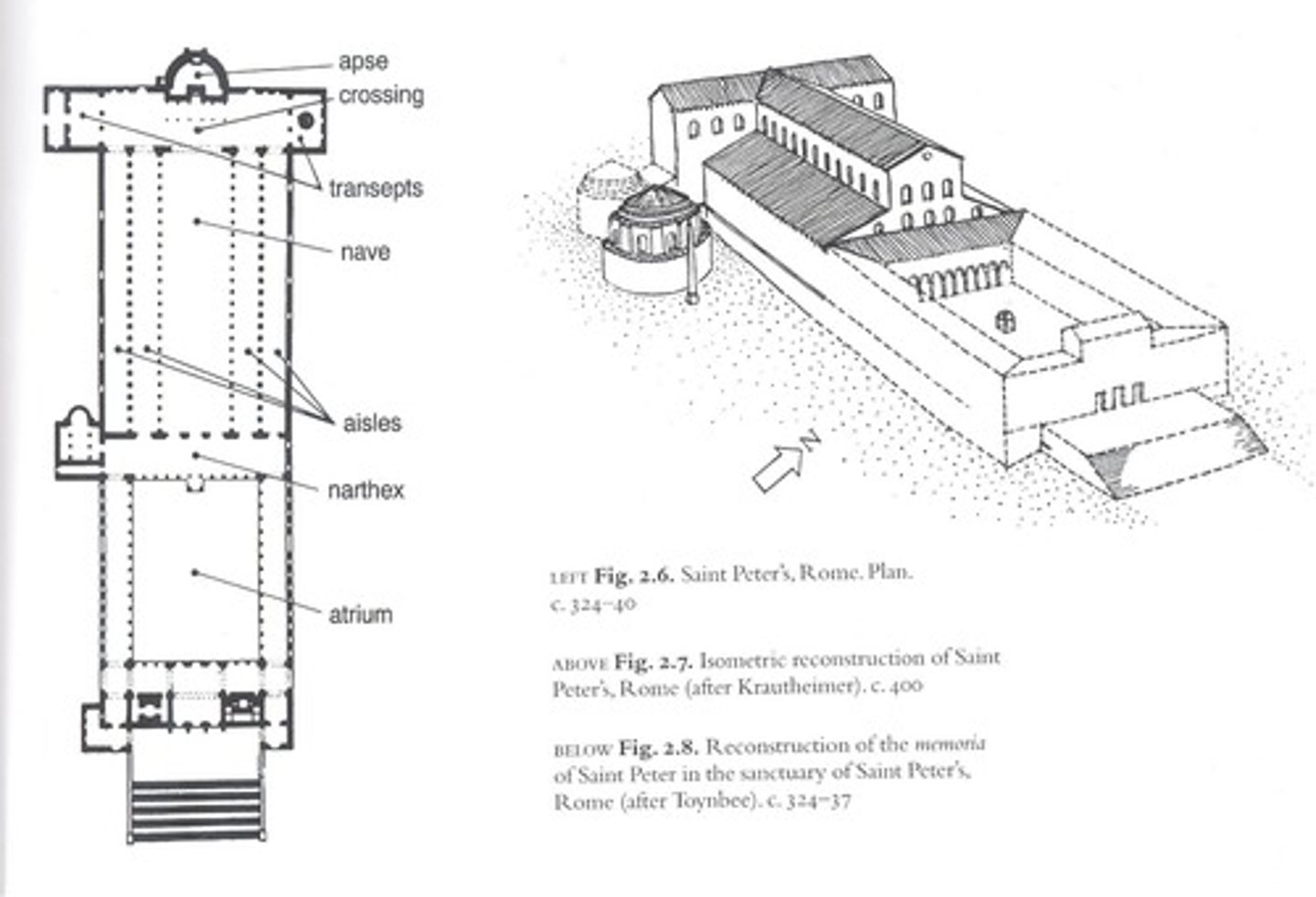
How did art stay alive after the fall of the Roman empire and during the "dark ages"?
MONASTARIES and monks whose common purpose was to wait and worship until Christ came gave them the opportunities to preserve all that was good and honoring; also...figured out how to install a stone ceiling (over wood) and ribs to support the heavy ceiling
Romanesque (1000-1150 AD)
Romanesque (1000-1150 AD)
return to the Romans, the external is more important than the internal (dark cathedrals), taller cathedrals because discovering how to hold up a stone ceiling
Church of the former Benedictine Abbey/ Murbach Abbey
1160 AD
in Murbach, France, mostly destroyed in French Revolution, only transept and choir remain, rounded arches for support, simple geometry (like the Romans)
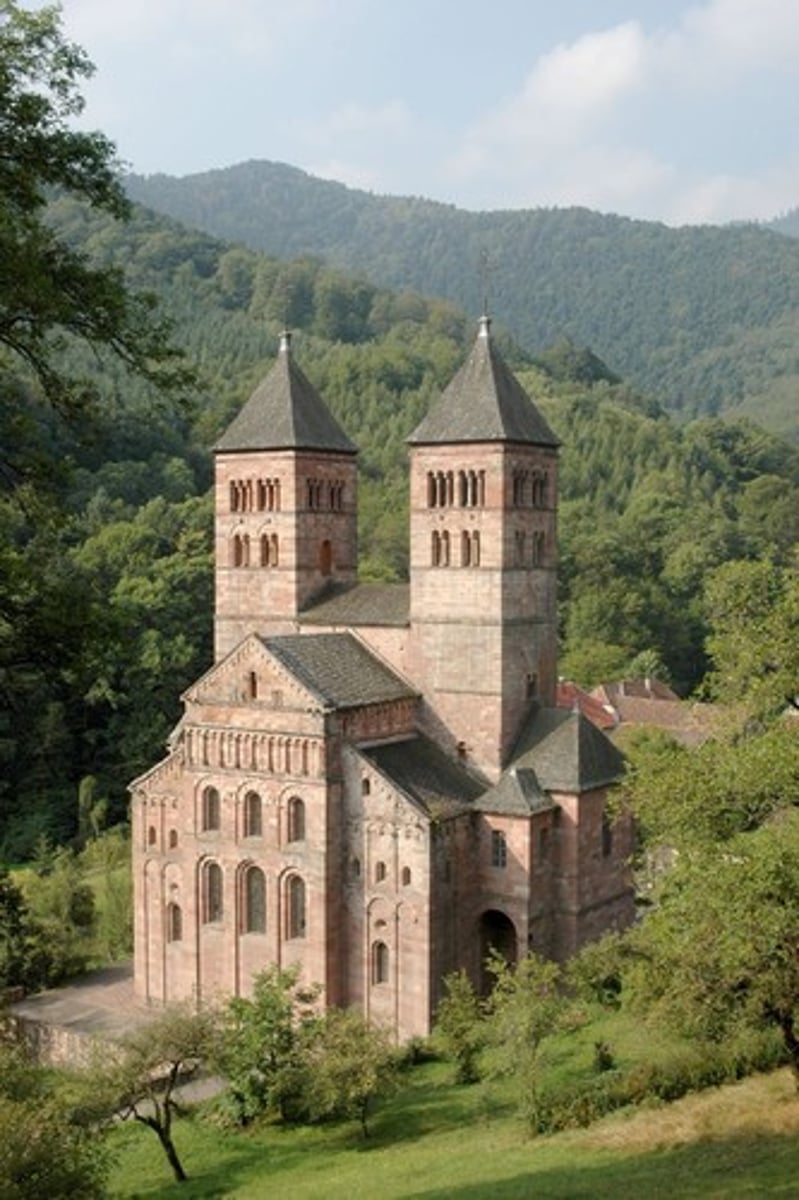
Tournai Cathedral
1171-1213 AD
in Tournai, Belgium, tall middle spire surrounded by mini spires, towers are 272 feet tall,
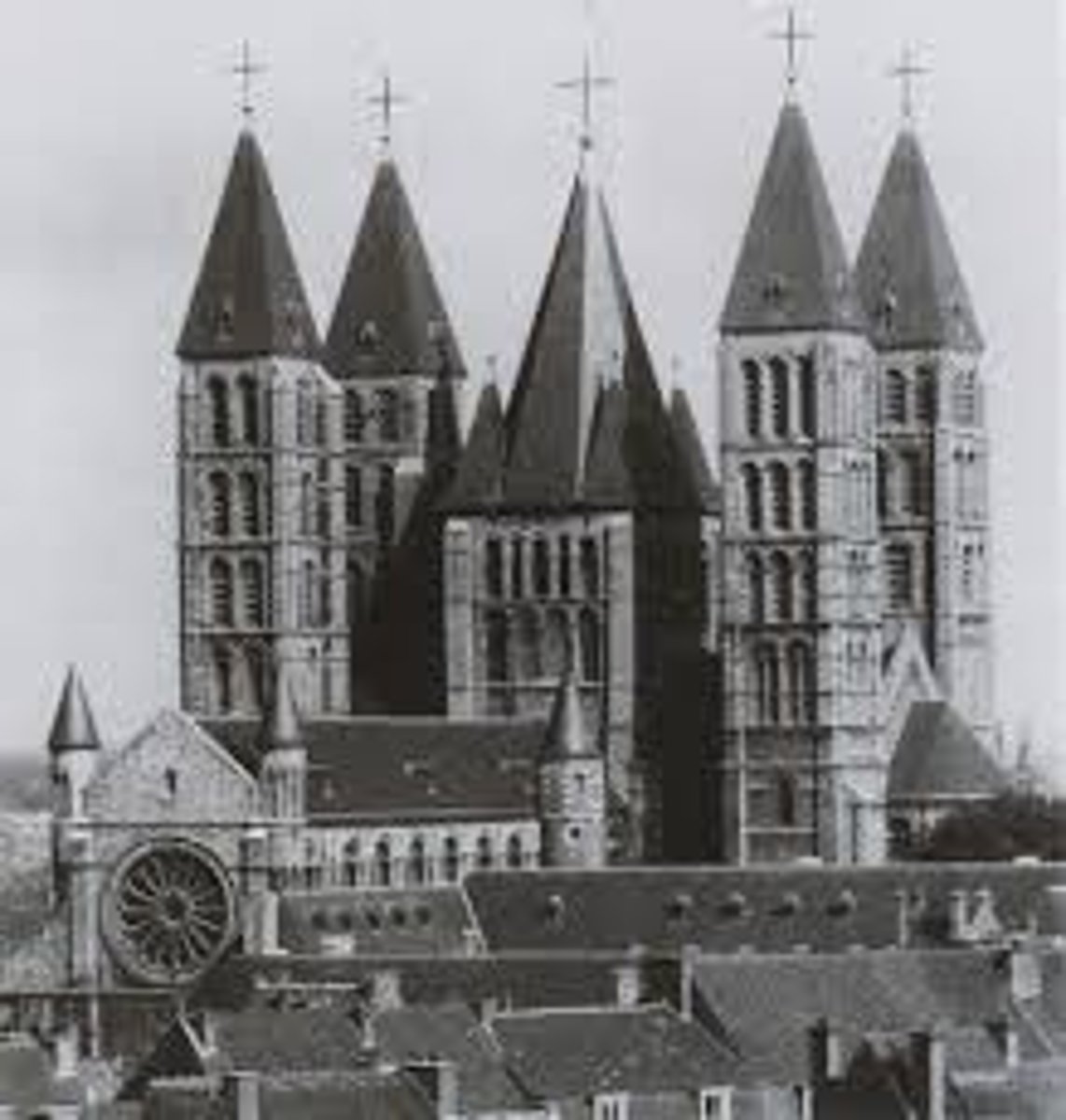
Durham Cathedral
1093-1128 AD
in Durham, England, ribs uphold ceiling, internally dark and abstract, intended to push you outside, 73ft high ceiling
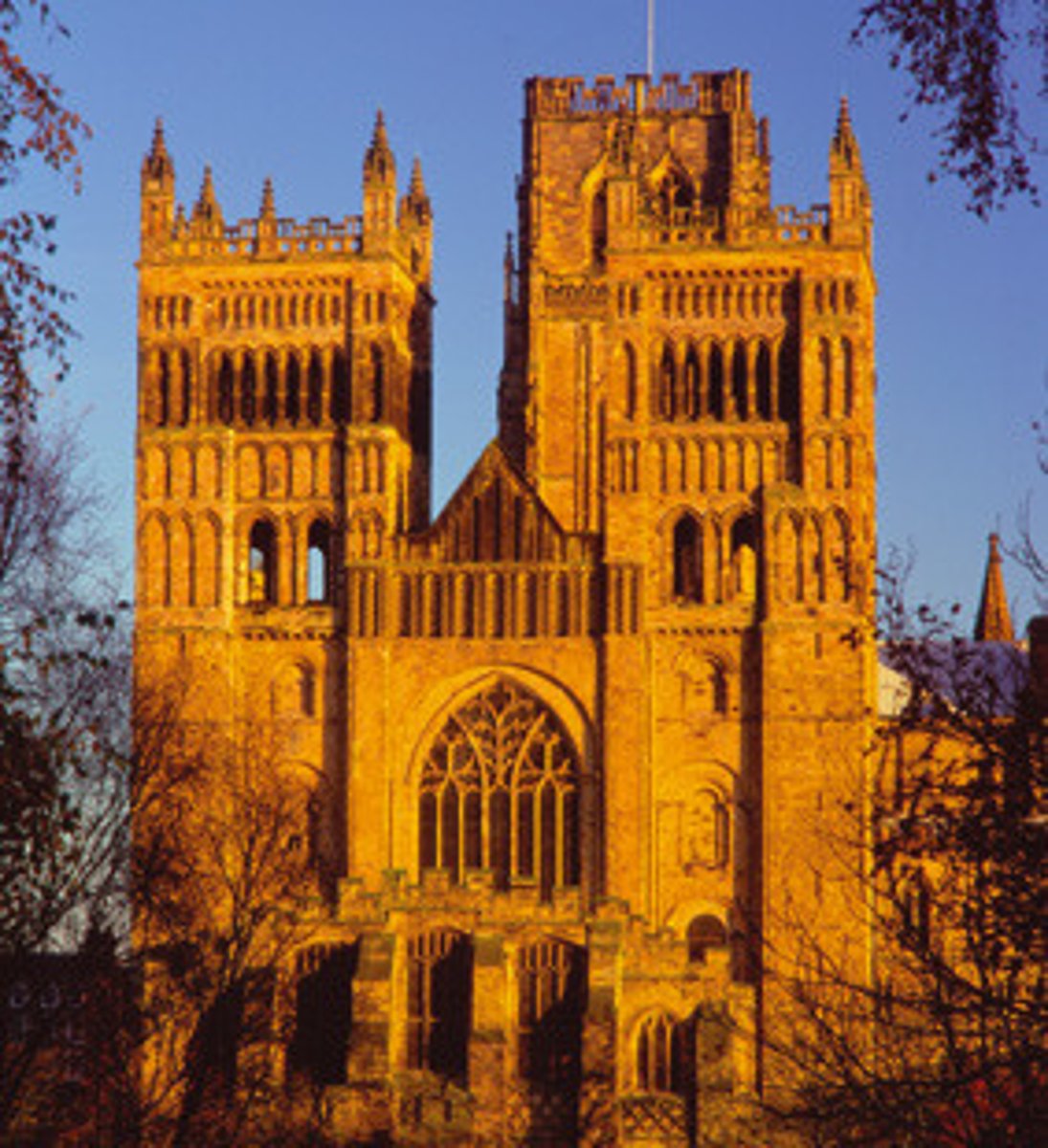
(West) facade of Church of Saint-Trophime
1180 AD
Arles, France, pictures of the last judgement, 12 disciples under Christ, above Christ is 4 disciples as animals holding books ready to make a case for the gospel on Judgement day

4 animals that disciples represent
Man: Matthew
Lion: Mark
Bull: Luke
Eagle: John
sign of speech
two fingers up (see picture example)
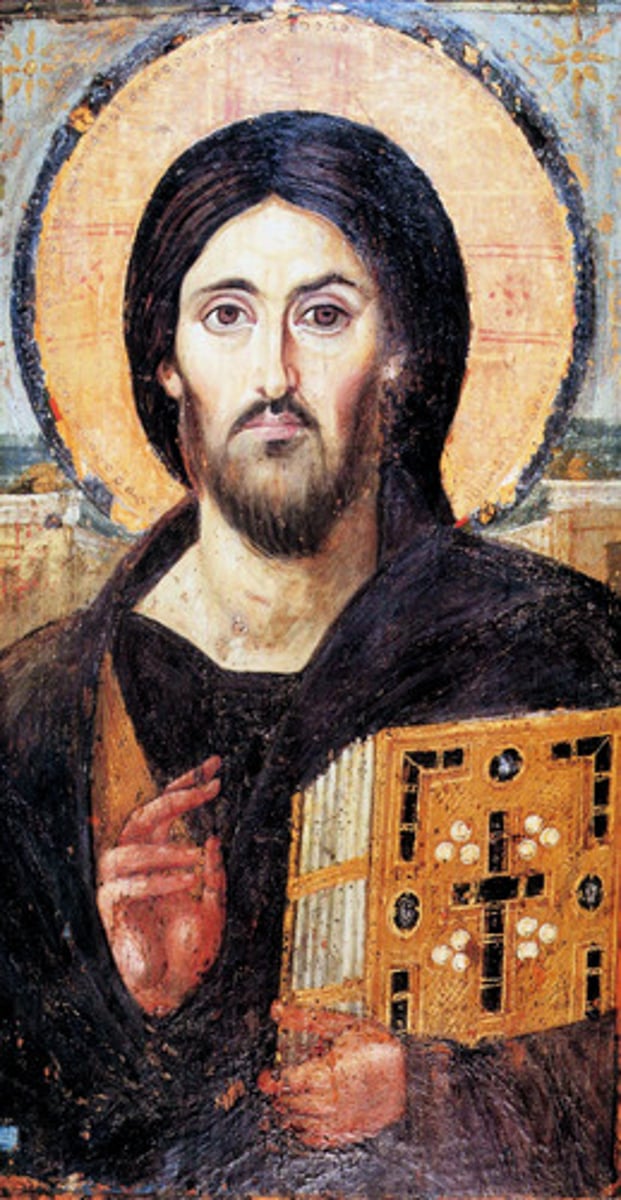
1st lintel on the facade
right is the praying redeemed, left is the chained damned, all people look the same
2nd lintel on the facade
mystical creatures
The Annunciation from the Gengenbach Gospel
1150 AD
not spatially realistic, traditional, SYMBOLIC, intended to point to heaven, the queen of heaven as she was right then to the monks, Mary's hands in submission, dove above Mary's head, angel's hands in speech and veiling heavenly glory, golden thread runs from the dove to Mary's head to show that she would have a child by the "power of the Holy Spirit"
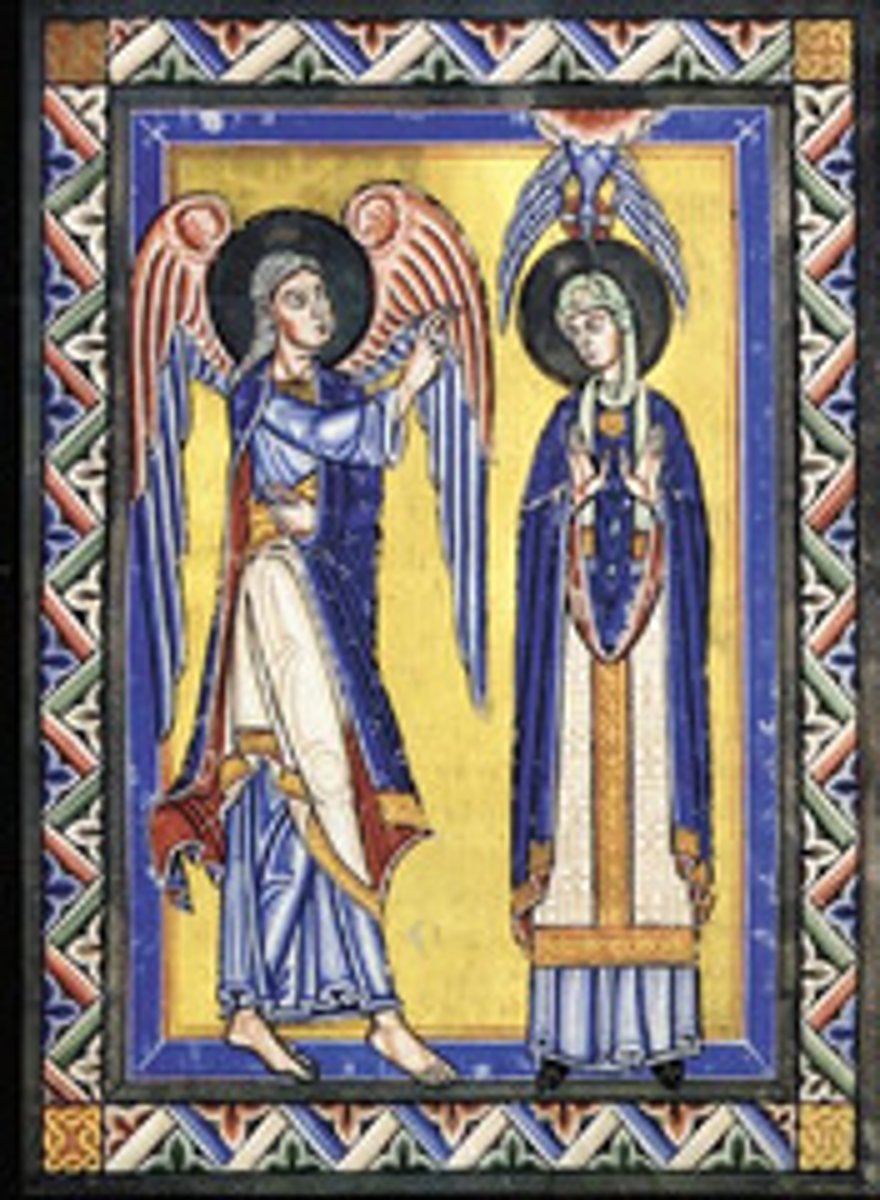
the dove in art represents?
Holy Spirit
October from a Calendar Manuscript in the Wurttembergische Landesbibliothek
1137-1147 AD
the dead martyrs (meaning "witness") speak, 2 inks (black/red), circle represents the thousands of maidens, Huns are out of the symmetry and therefore bad
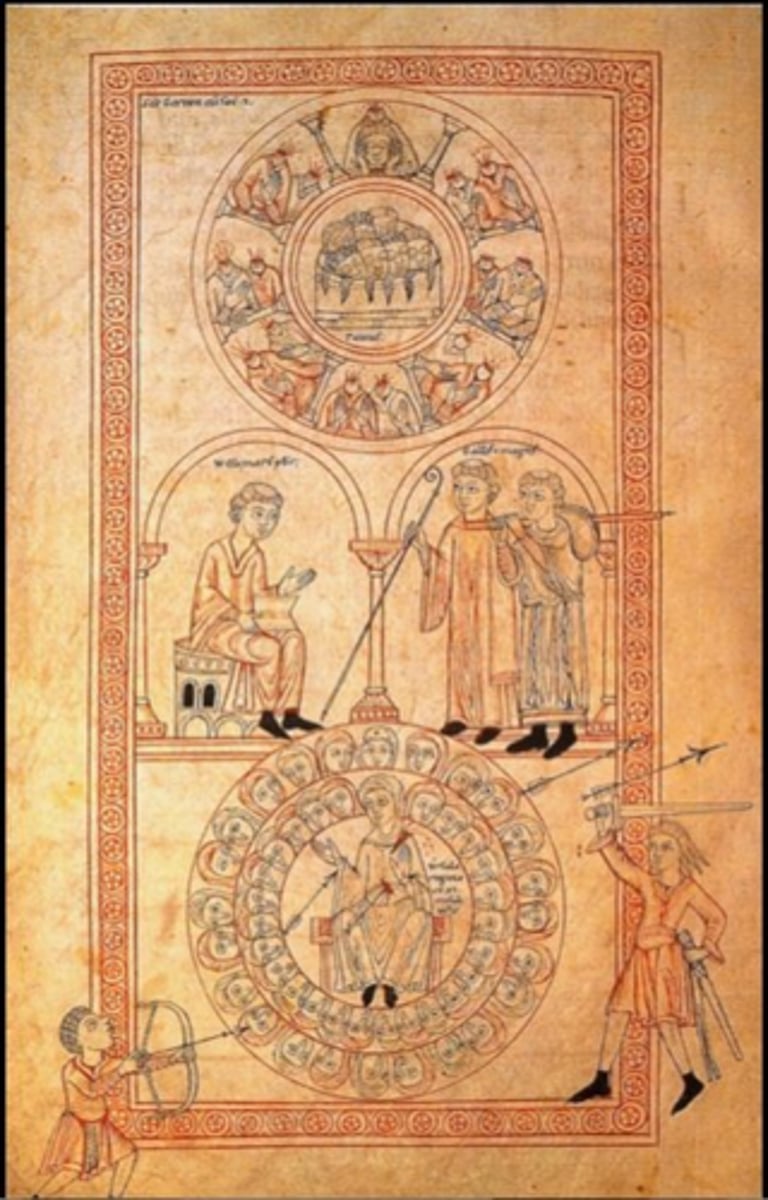
Gothic
Gothic
focus on the heavenly things and convey heavenly messages, difficult times toward the end (100 years war, Black Plague, harshest winters ever), intended to overwhelm with extravagance and mystery
How did the Gothic period come about?
Abbott Suger, Abbot of St. Denis (1081-1151 AD)
structure and beauty of church shows how you believe and think about God and worshipping Him...can't worship in the (Romanesque) dark... GOD IS LIGHT
Abbott Suger's two ideas for more light
1. pointed arch > round arch; stronger to hold up vaults and allow for more windows, more height as well (more height, more light)
2. buttresses= structural ribs as support for buildings; flying buttresses move off the walls/vaults and support for more windows
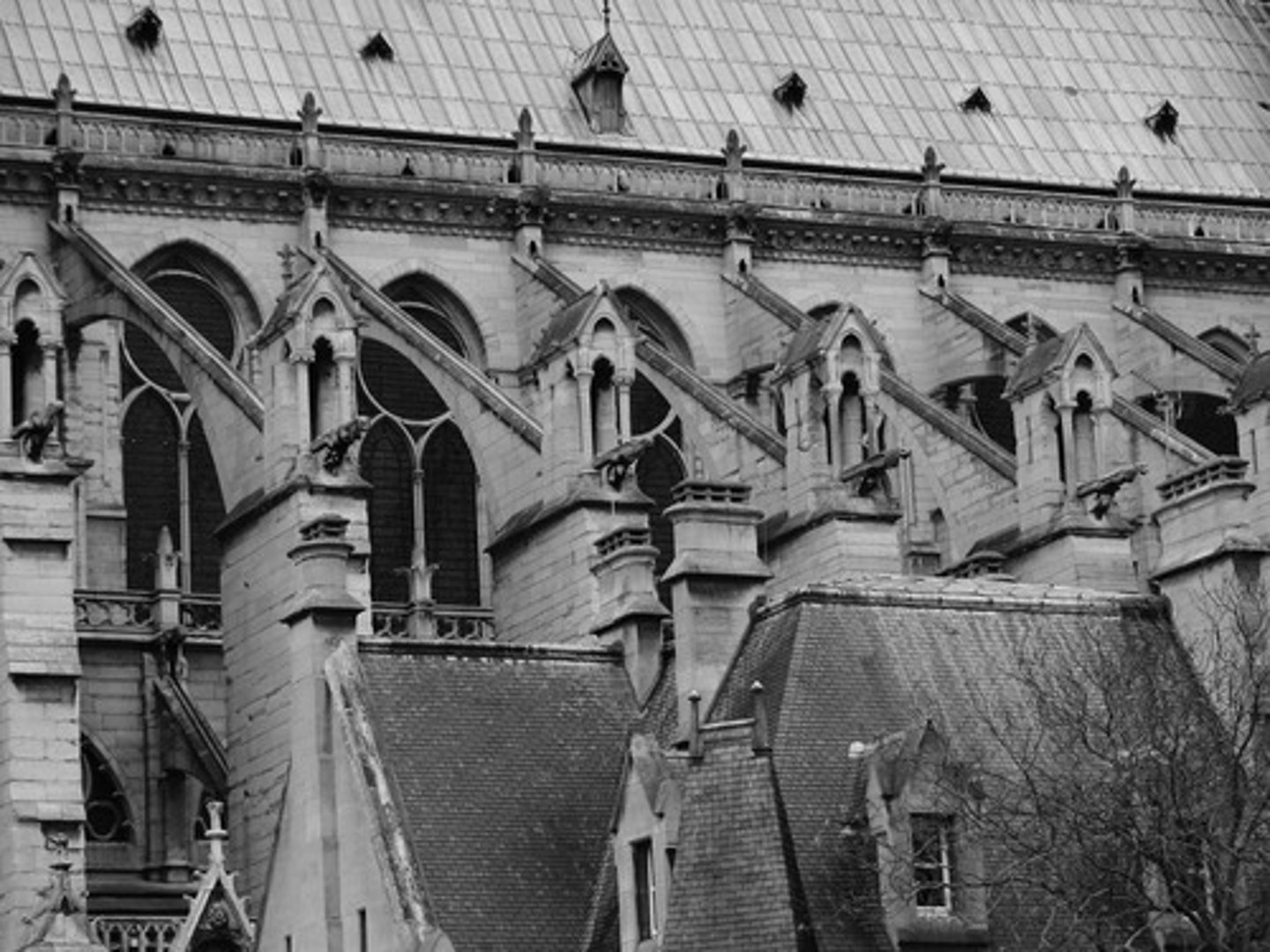
Amiens Cathedral
1218-1247 AD
in Amiens, France, intended to overwhelm, 144 FT TALL
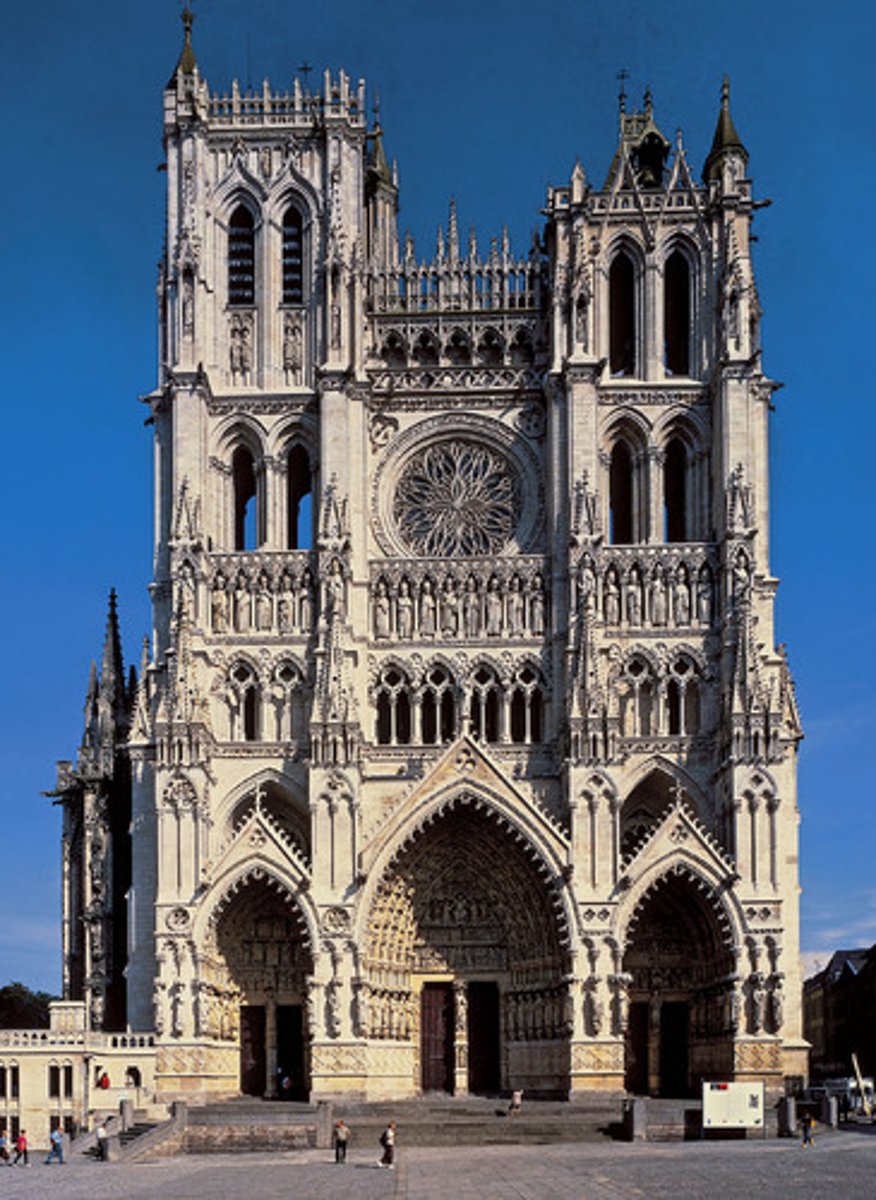
La Sainte Chapelle
1243-1248 AD
MOST LIGHT, in Paris, France, more glass to surface area anywhere, "kaleidoscope worship", interior colors change with lighting and seasons
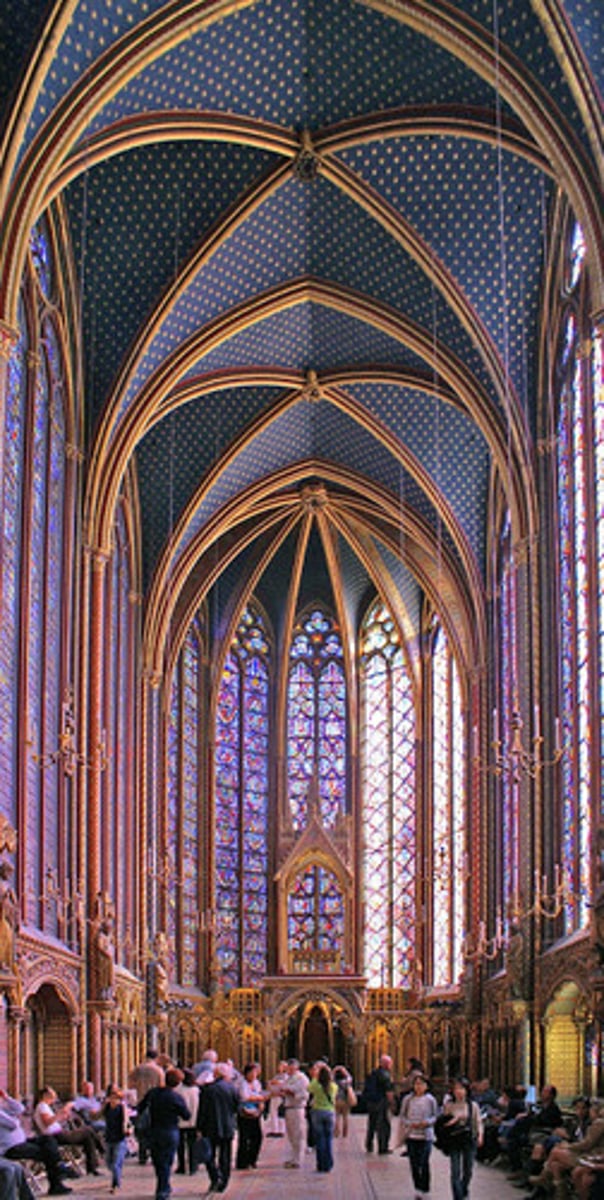
Cologne Cathedral
1248-1880 AD
MOST HEIGHT, in Cologne, Germany, went without a roof for 500 years, 202 ft vaults
Chartes Cathedral
begun in 1134, rebuilt in 1194 AD
in Chartes, France, city of Chartes (>10,000) funded and built cathedral
Chartes Cathedral north and south sides
north- OT pictures (in shadows of the gospel)
south- NT pictures (in full light)
North Transept of Chartes Cathedral
graceful sculptures/statues (elegant compared to the stiff ones of Sainte Trophime), 4 figures
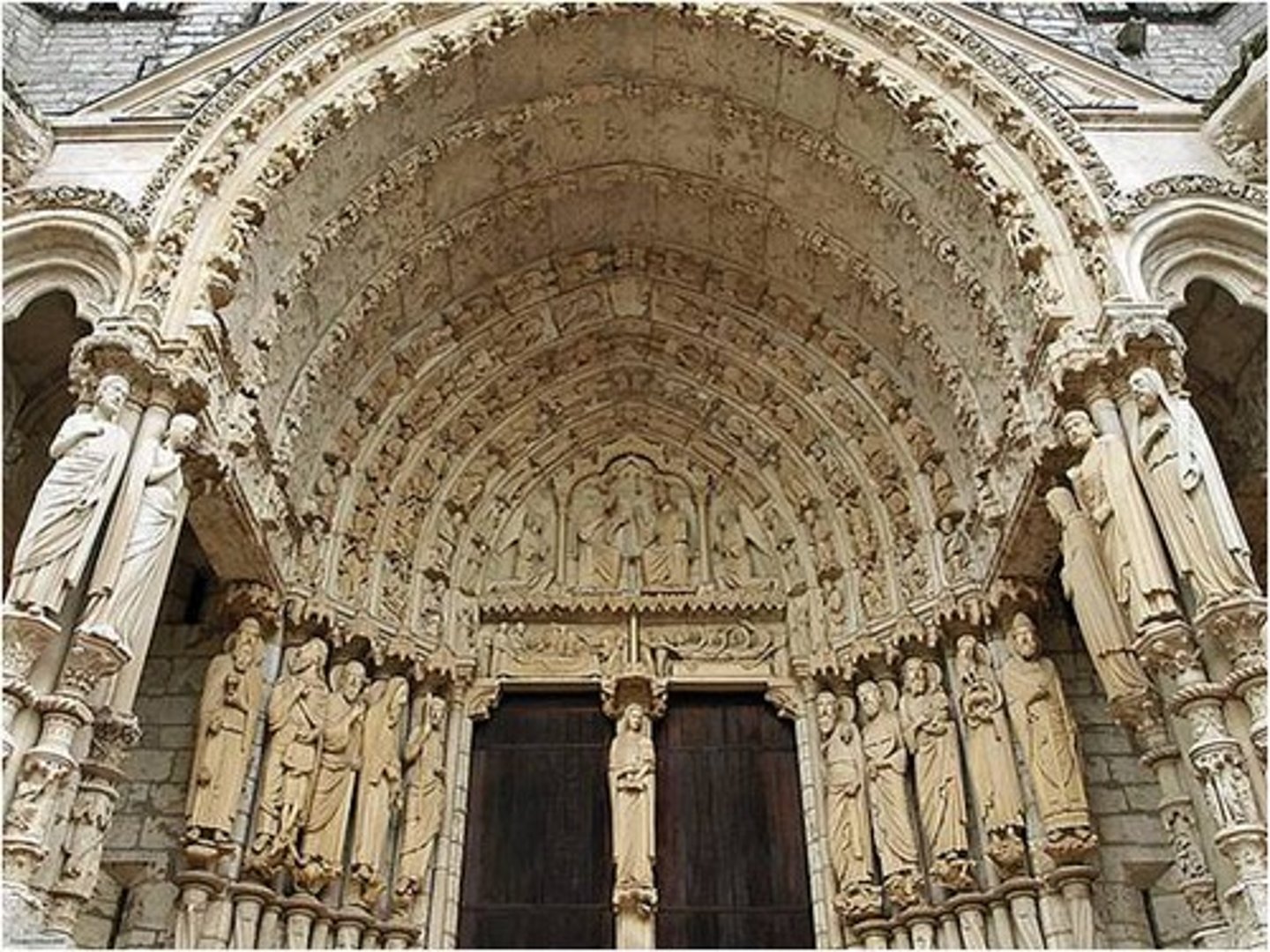
4 figures at Chartes Cathedral
Melchizedek
Abraham
Moses
Samuel
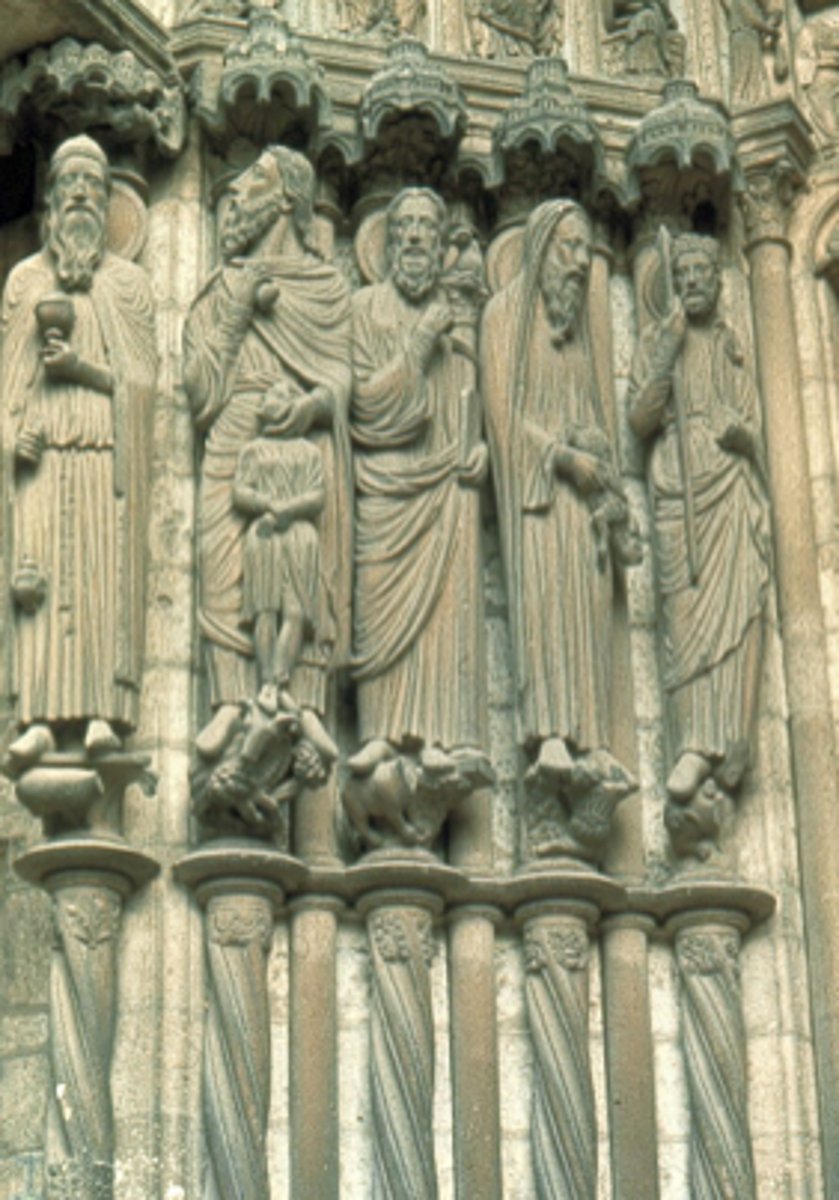
Melchizedek (Chartes)
lamb under feet, holds the priestly censer and chalice, priest and king
Abraham (Chartes)
holds a knife with Isaac at his side, ram at their feet, Abraham looks up to the angel above Melchizedek
Moses (Chartes)
dragon on a pole representing (Jesus made sin on the cross), holds the commandments, golden calf at his feet
Samuel (Chartes)
head is covered, holding a lamb and knife, man under his feet looking up (he represents the prophet, priest, and kingly roles of Christ)
Annunciation from the Infancy of Christ Window in Chartes Cathedral
incredibly preserved, Gabriel speaks (two fingers) and is a royal messenger (holds scepter)
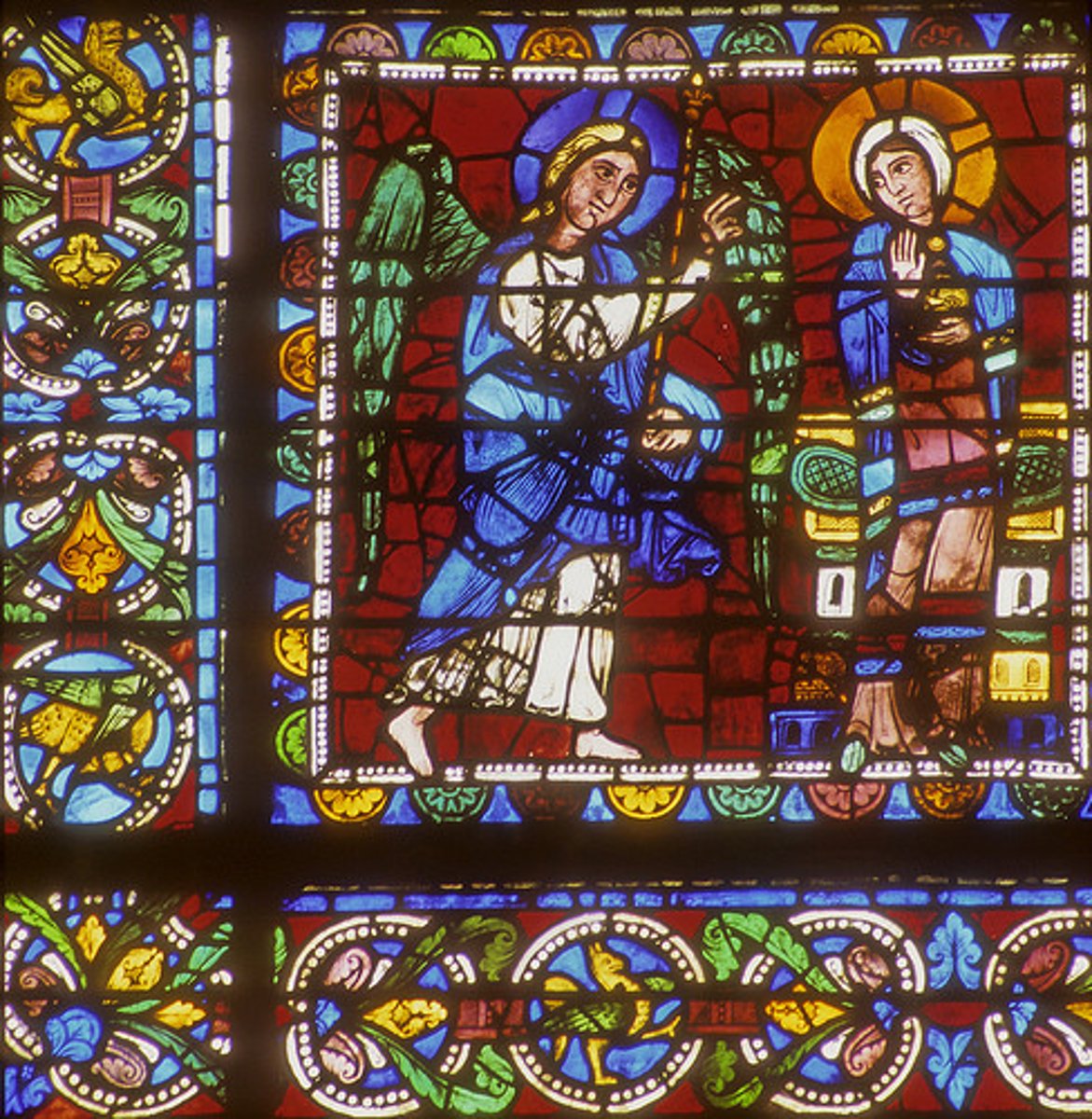
Renaissance
Renaissance, "rebirth"
resurgence of humanism (higher view of man), more focused on the world man lives in than heaven because heaven cannot be conveyed, use the world to convey a message
Dome of Florence Cathedral
Brunelleschi, 1420-1436 AD
in Florence, Italy, dome within a dome for stabilization, gothic cathedral, classical ideals (2:1 ratio of height: width), Brunelleschi constrained by gothic ideals
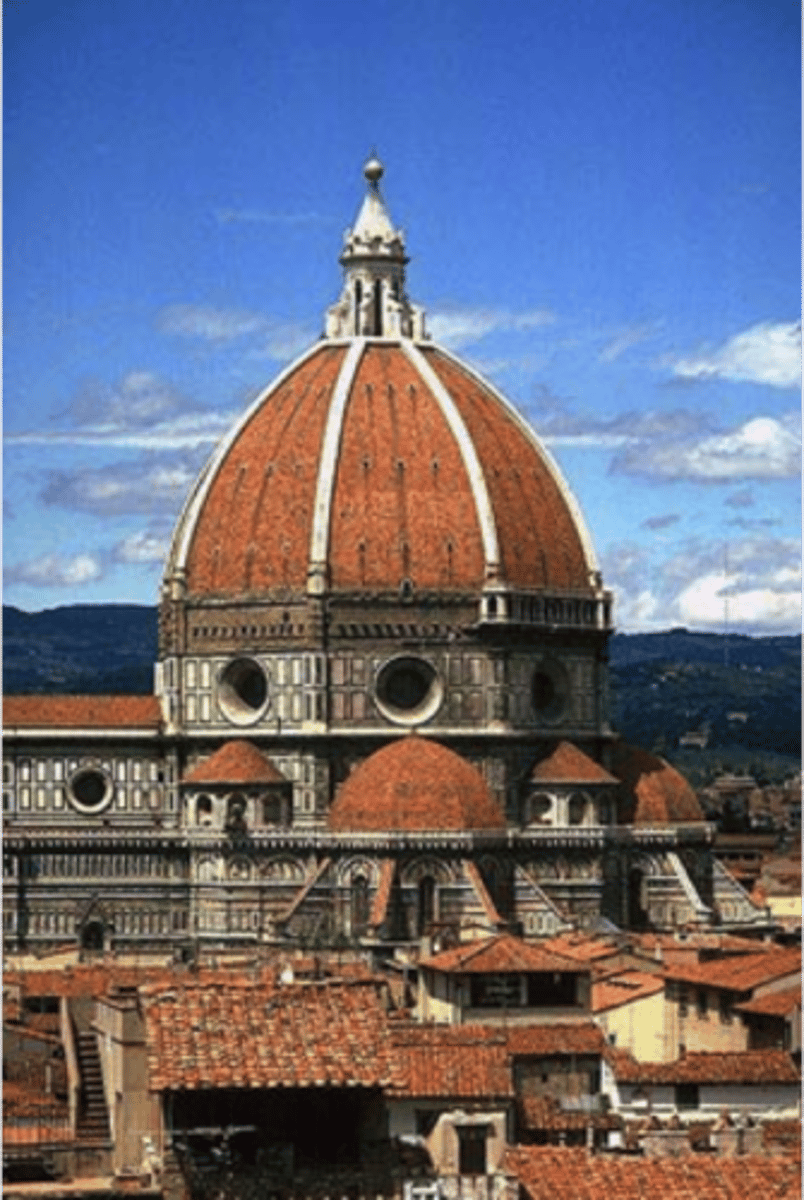
Pazzi Chapel
Brunelleschi, 1430 AD
in Florence, Italy, inspired by Roman/Corinthian porch, no gothic mystery or grandeur, classical values (rectangular floor, circular dome/medallion/arch, triangular pediment, square and triangular windows)
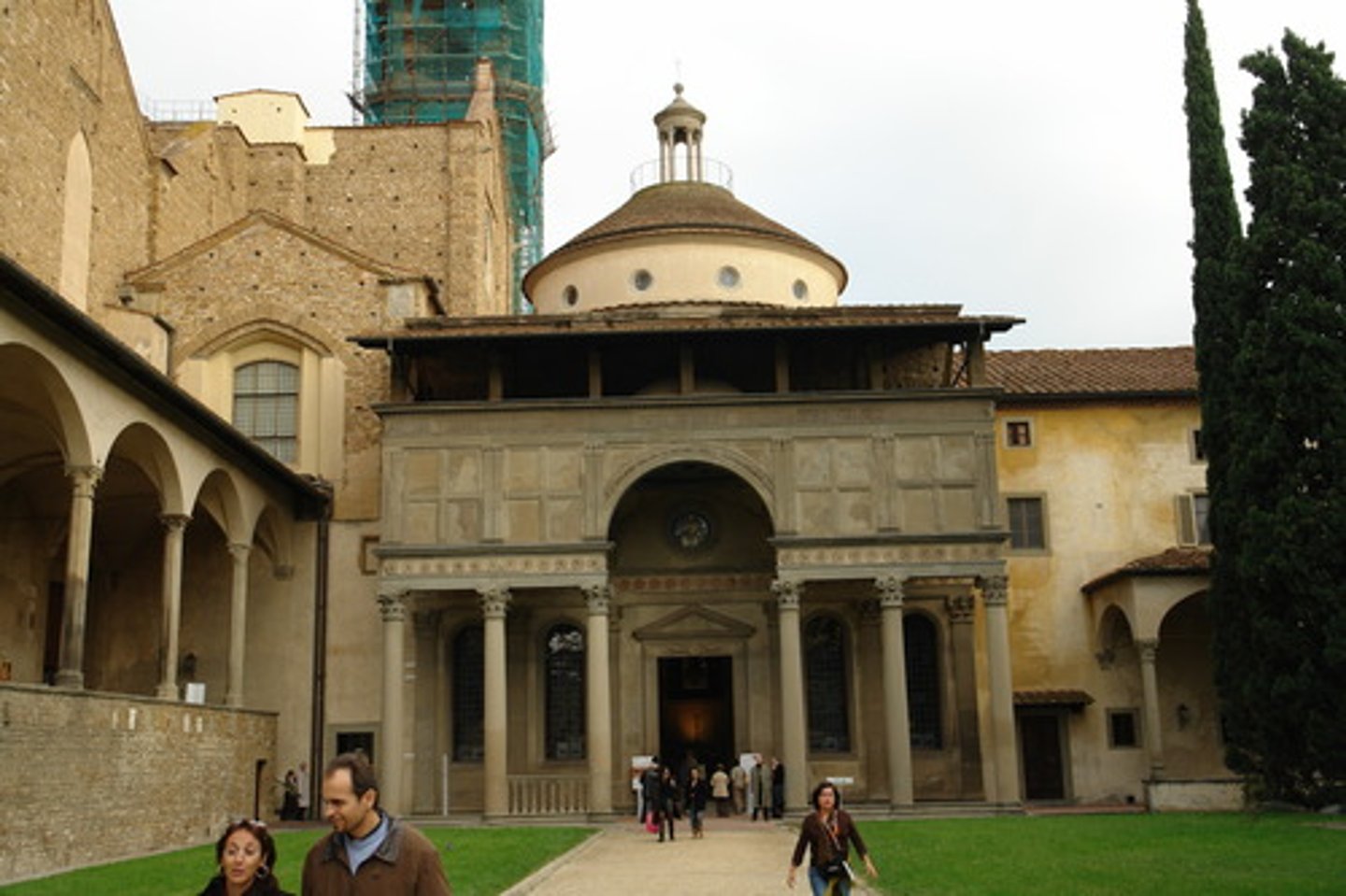
Pazzi Chapel interior
inside columns aren't for support but to show a humanistic vision to allow people to understand the forms they worship in (Roman values)
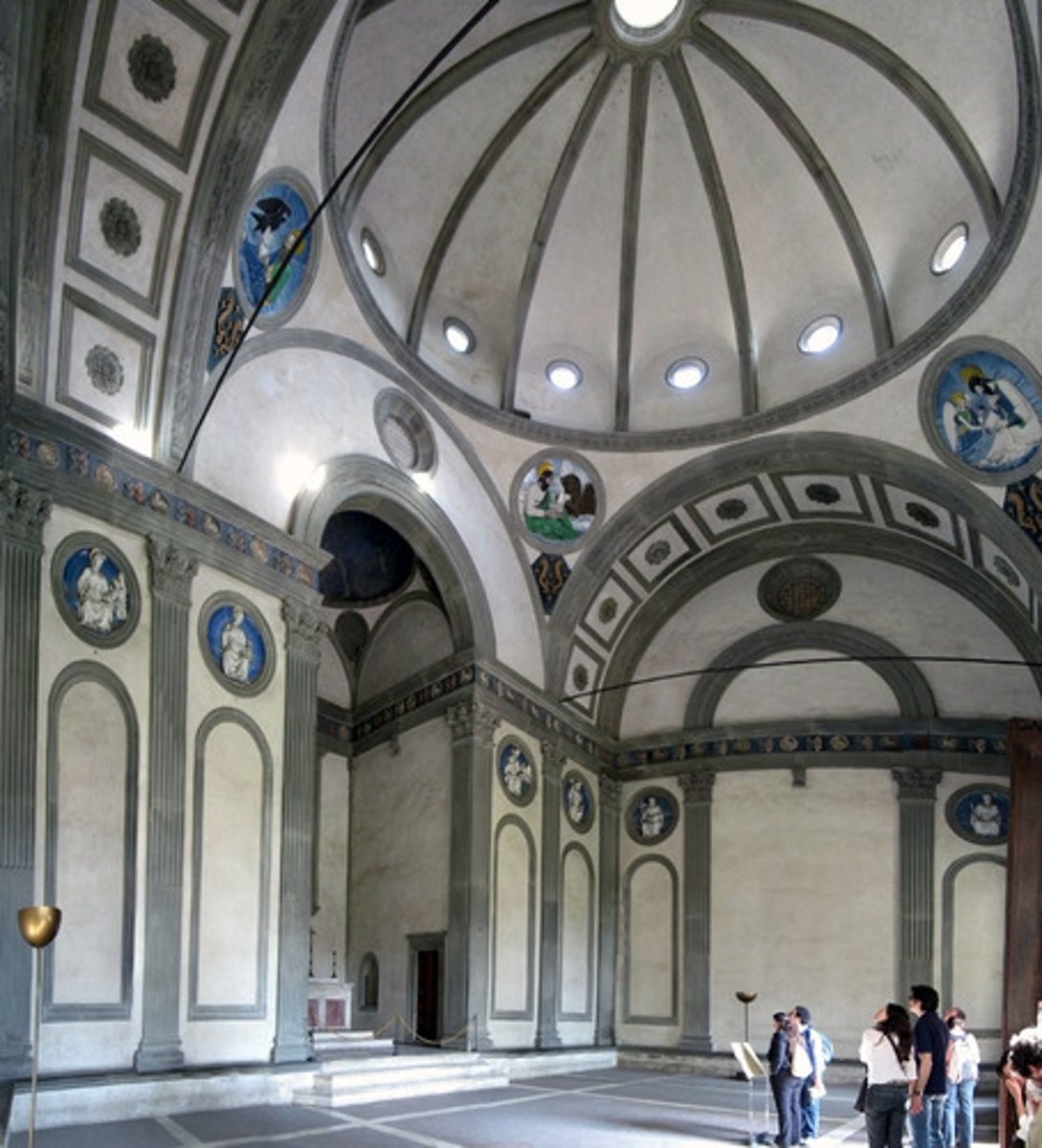
Adoration of the Magi
Gentile da Fabriano, 1423 AD
very gothic, pointing heaven-ward, super grand
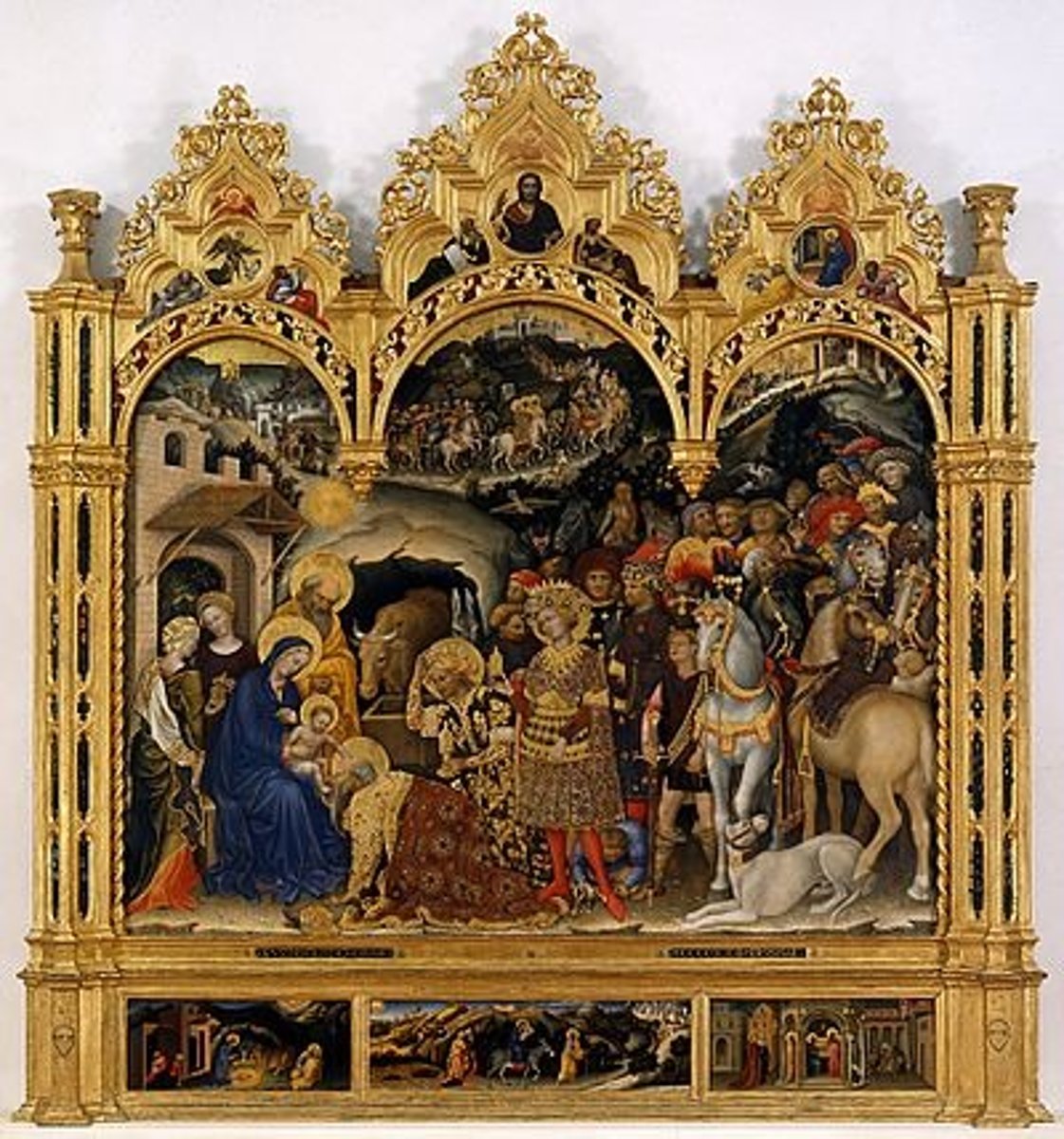
The Holy Trinity
Masaccio, 1428 AD
in Florence, Italy, fresco (painting on wet plaster), 22 ft tall, painting of the Trinity (dove, Father, Jesus), triangular shape between Jesus/Father and lower figures to symbolize the Trinity in a perfect triangle, Mary and John at Jesus's feet, 2 patron saints on edges, very symmetrical (color, people)
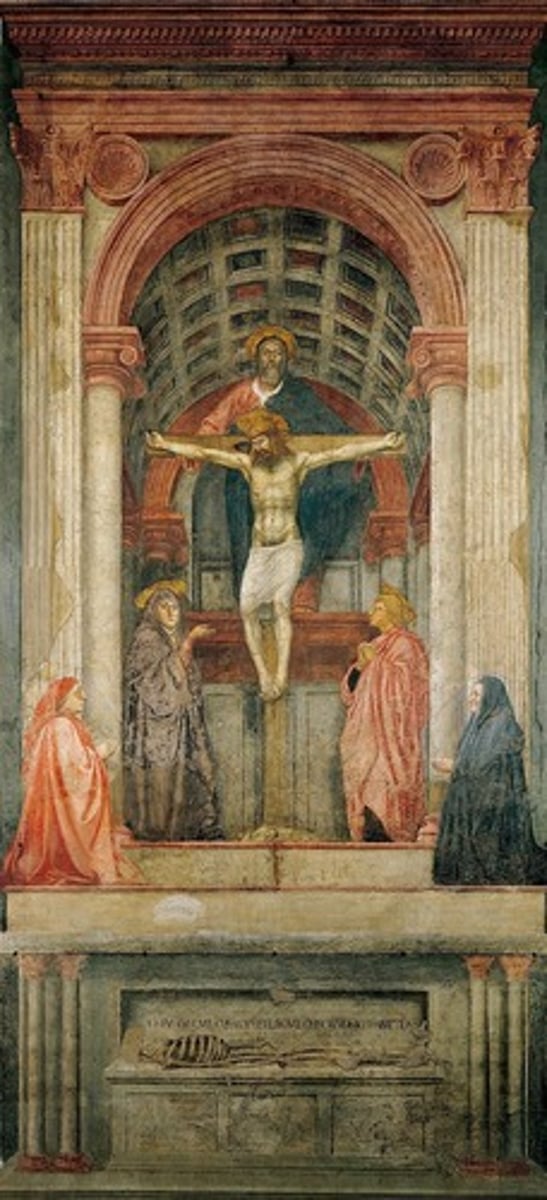
Why is the trinity in "The Holy Trinity" inside the building?
1. They are on the altar to symbolize the physical Eucharist
2. classical architecture
3. opportunity for linear perspective, locates the viewer in the space of the painting!!!!!, places viewer into the art to view the looming Trinity
linear perspective
where parallel lines converge at a point(s) on the horizon
history: discovered in the 14th/15th century, math to draw the eye to a certain point(s) in the art, allows the art to be viewed from a certain angle/perspective, to convey theological messages in human terms
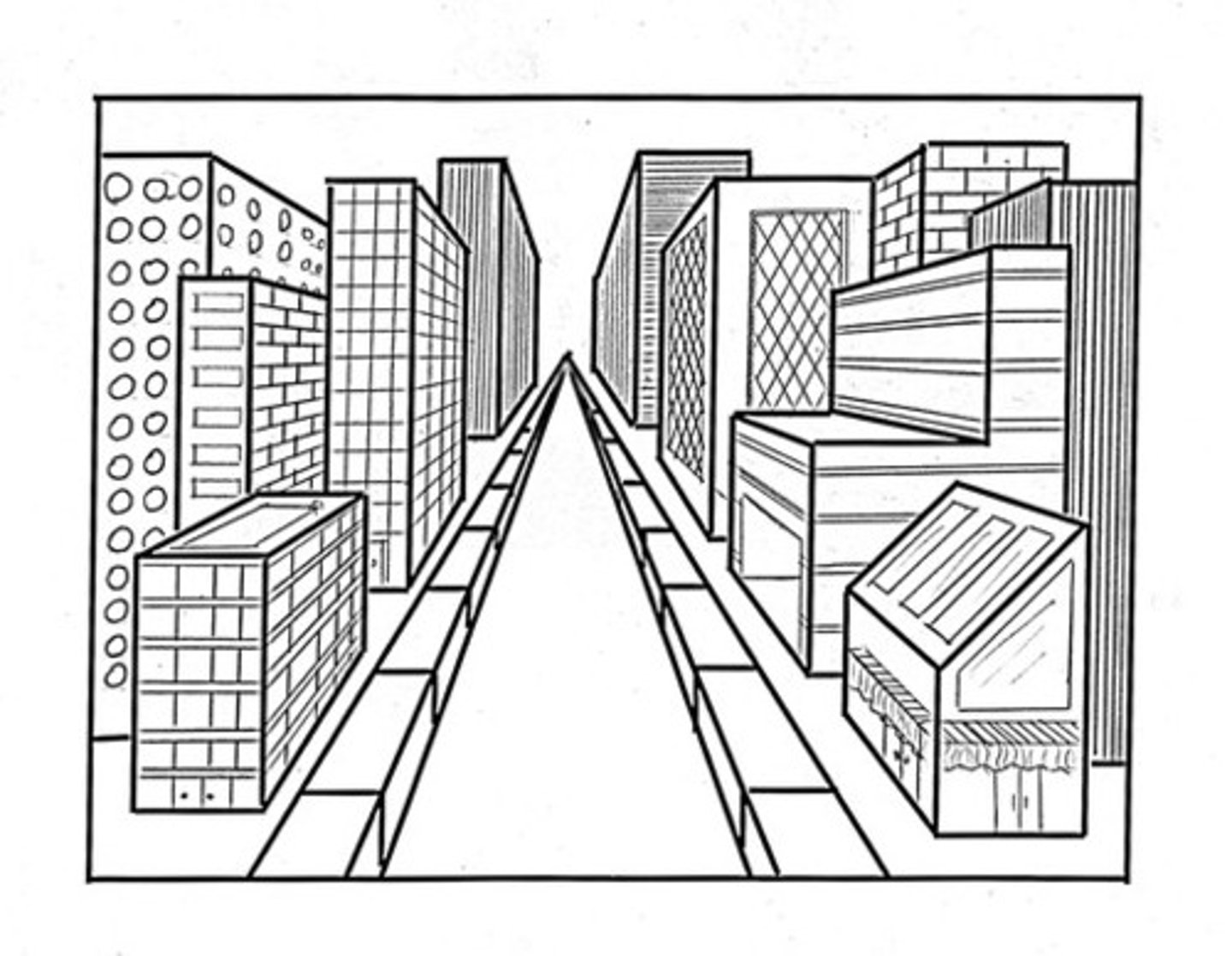
Where is the focal point in "The Holy Trinity"?
at eye level, lintel under Jesus where the patrons stand, looking up at Jesus
Why is "The Holy Trinity" in a Dominican/monastic church?
wanted to minister to others about the perfect fellowship of the Trinity, trying to use your experience to experience God's love, Mary directs your attention to the Trinity to say love like God does
What is at the bottom of the painting? Why?
skeleton/tomb, above is "As you are, so I was. As I am, so you will be.", reminder of mortality
St. George
Donatello, 1415-16 AD
in Florence, Italy, sculpture AND mannequin for the armory guild, stands contrapposto, leans forward in anticipation of the dragon, intended to convey the soul/character of a hero not just the bodily look
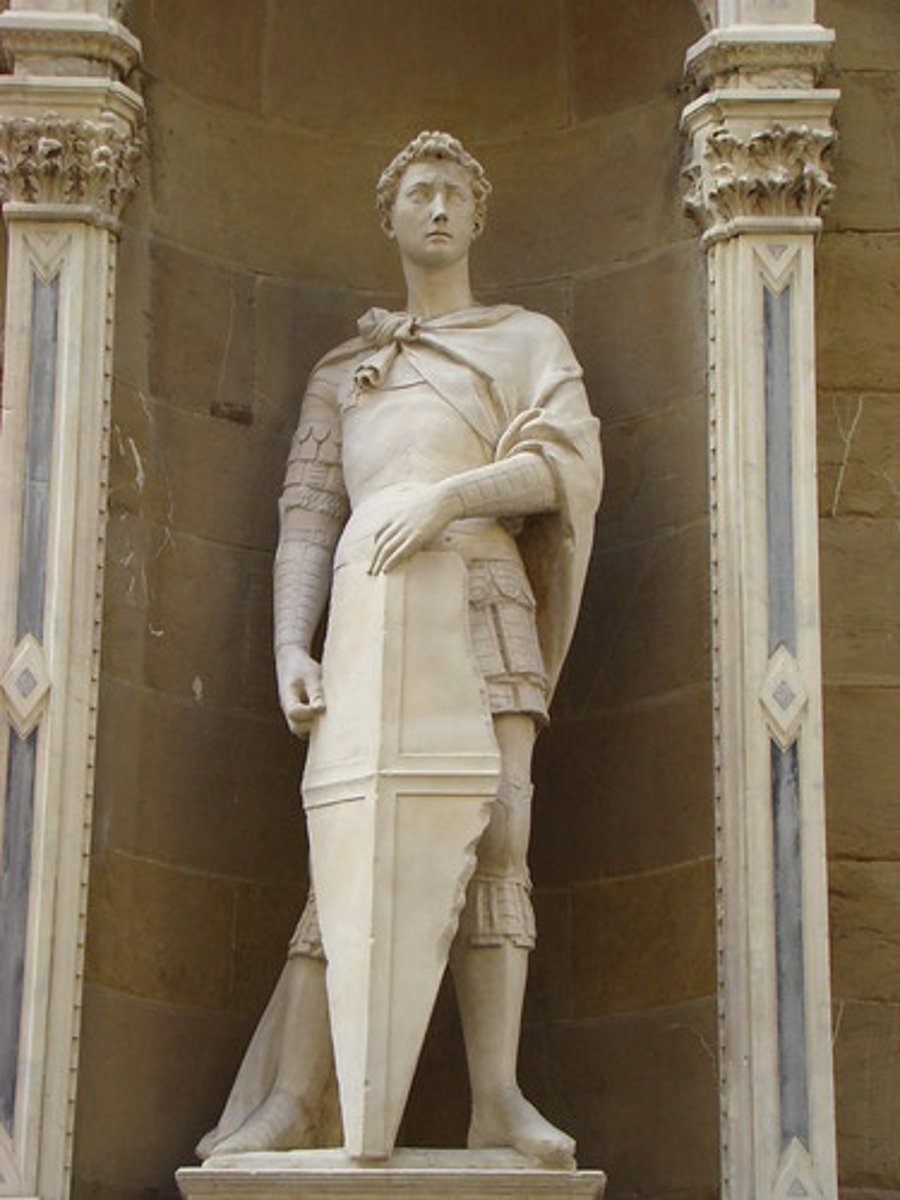
Saint James led to Martyrdom
Mantegna Andrea, 1455 AD
in Padua, Italy, destroyed in WWII, St. James in focus because of green and halo, 1st to be martyred, linear perspective, chiaroscuro, spatially realistic, historically realistic

chiaroscuro
source of light that all shadows follow (spatially realistic)
Why does the linear perspective conjoining underground at the bottom of the picture?
in the chapel viewer would be standing down some steps, puts you in the same position/view as the scribe (convey religious message that you can experience)
reason for the disorder of stable/looming unstable building?
vertical lines should converge at the top but don't...lines are same width instead of converging and the disorder represents the disorder of the scene (Romans vs. Jews, heavens are angry, scales are unbalanced and UNJUST)
Story of James's execution
scribe testifies against James, experiences an unfair trial, scribe then realizes and repents at James's feet and is martyred with James
Constantine's Dream
Piero della Francesca, 1460 AD
moment and decision of history and established Christianity, foreshortening, shape of tent inside gives painting a cross shape

foreshortening
larger/size change to pull item out of the picture (3D)
Northern Renaissance (1400s)
Northern Renaissance (1400s)
Flemish/Belgium, slower than Florence/Italian shift in art, realism in detail
Ghent Altarpiece
Hubert and Jan van Eyck, 1432 AD
backdrop for Eucharist, oil on panels (intention and slow)
Open Ghent Altarpiece
Revelations Last Judgement, ordered to the Medieval mind, Trinitarian vertical axis (God the father, lamb pouring blood (Jesus), well of life (Spirit), no spatial realism, God has a magnificent throne, robes with "King of Kings and Lord of Lords", churchly crown, Mary to the left of Father reading a book because she no longer has to intercede, John the Baptist on the right, musicians, Adam and Eve on a moving hinge to turn in so they can see the salvation of their family, representational groups in each corner (NT saints, OT saints, martyrs, angels around the lamb, etc.)
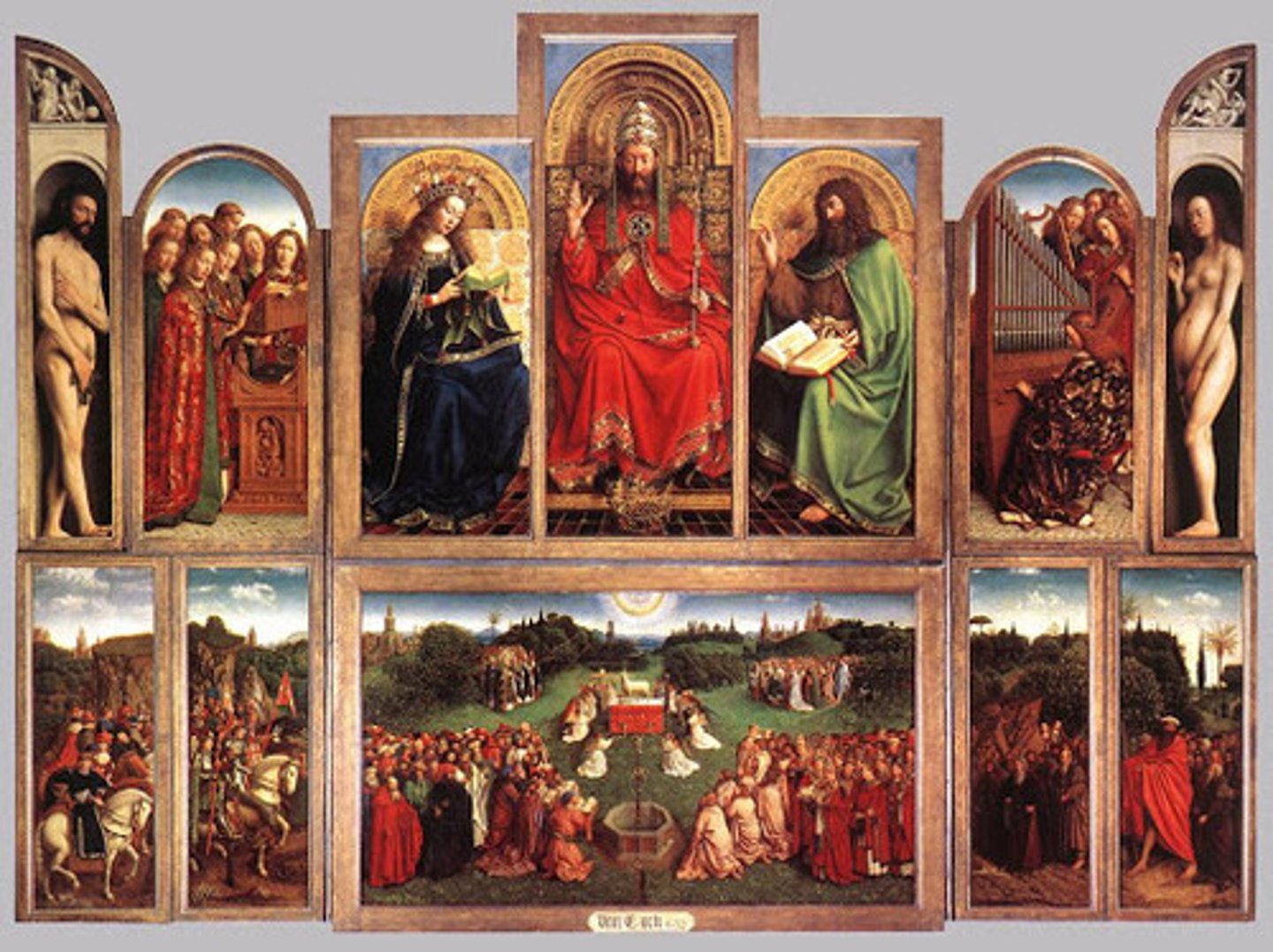
Closed Ghent Altarpiece
annunciation scene (Mary and Gabriel), no linear perspective, no historicism, no anatomical reason (pale, buried under clothes), realism of detail (oil paint for perfection), symbolic details filling small spaces (ex. lilies, pot, linen, etc.), sibyls above Zechariah and Micah all foretelling of Jesus's coming to pagans and Christians, the glorified saint (John the Baptist, John, brother of James) is a painted sculpture, patrons on the bottom corners
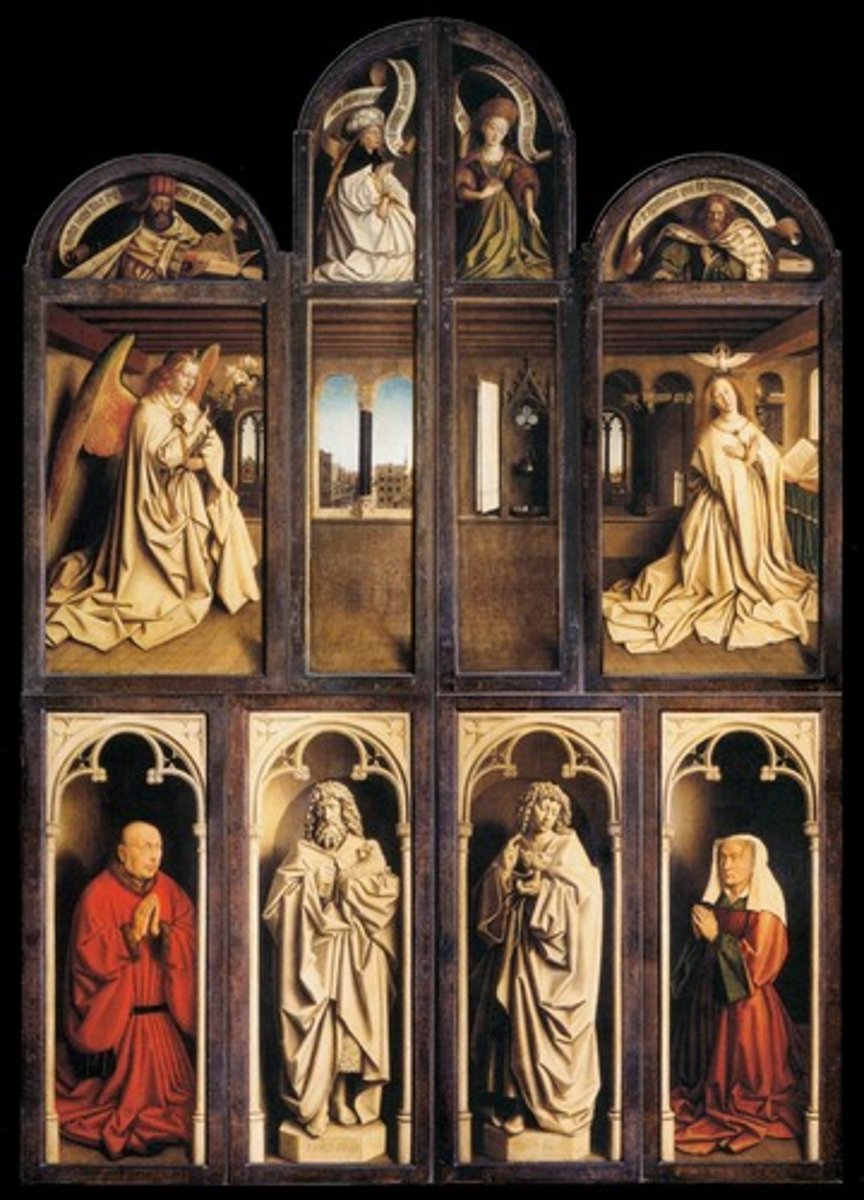
The Descent from the Cross
Rogier Van der Weyden, 1435 AD
free from spatial realism and able to give the maximum symbolic meaning, figures balanced on either side of cross which helps viewer to trace the body of Christ, bold colors make your eyes bounce and restless (like the restless soul), Mary's form mimics Christ's form (she "dies" too) and their open arms invite viewers, multiple planes all point to the skull at Mary's hand
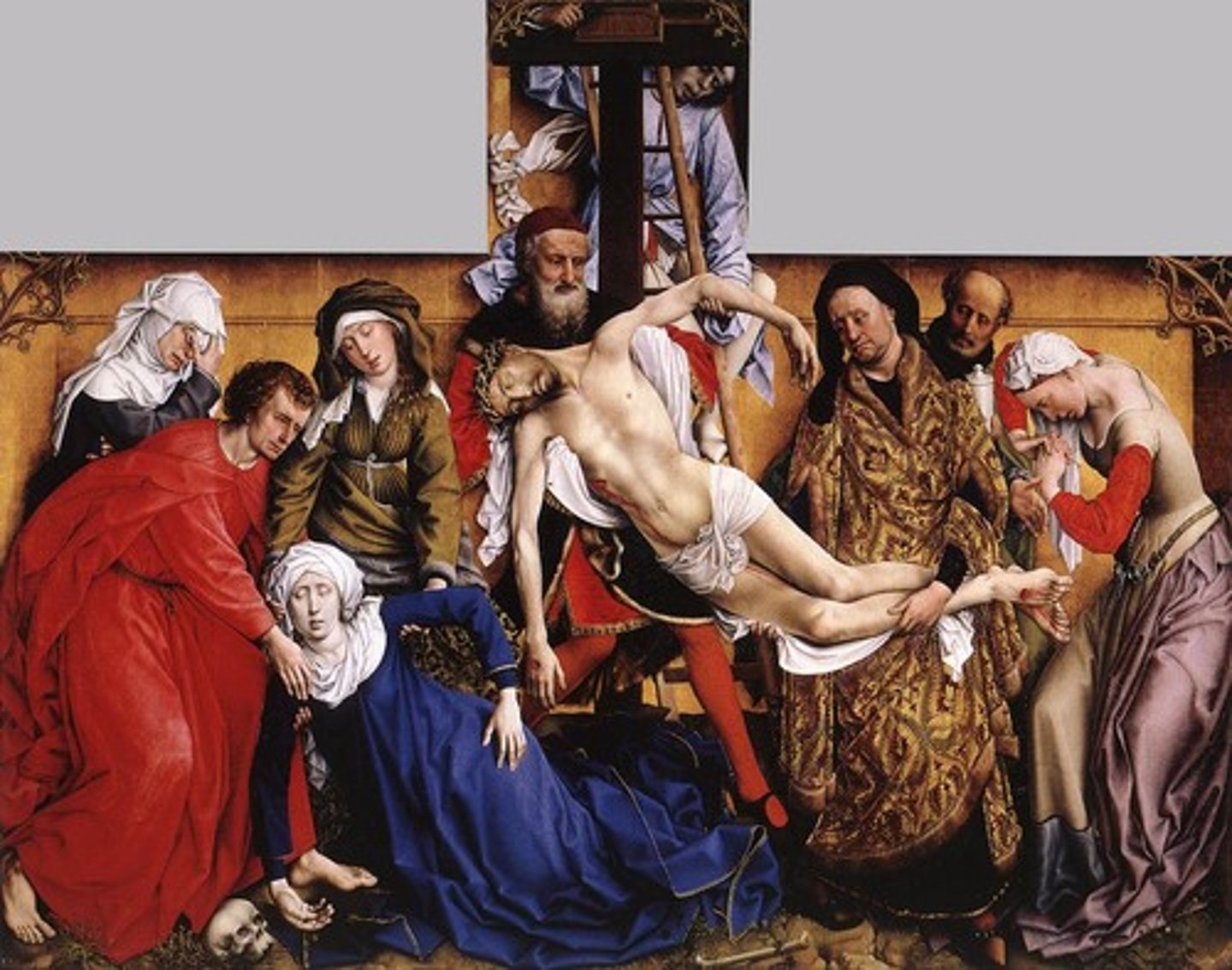
High Renaissance
High Renaissance
practically all Italy (Rome), top 3 artists- Da Vinci, Michaelangelo, Raphael
The Last Supper
Leonardo Da Vinci, 1495-98 AD
in Milan, Italy, thought he found a way to paint a slow fresco...nope now it's peeling, untraditional Last Supper painting (most showed the blessings of the bread and wine), changed because this painting was in a dining hall not a worship area and made it a photorealistic extension of the monastery dining hall, as if Jesus was dining with them, apostles in pairs of 3, Judas is the only one who recoils back from Jesus and holds the $$ bag, Jesus is the center/focal/vanishing point of the whole painting, he is the only relaxed and controlled one, 3 panels of creation behind Jeus's head, arch and plate complete a circle around his head
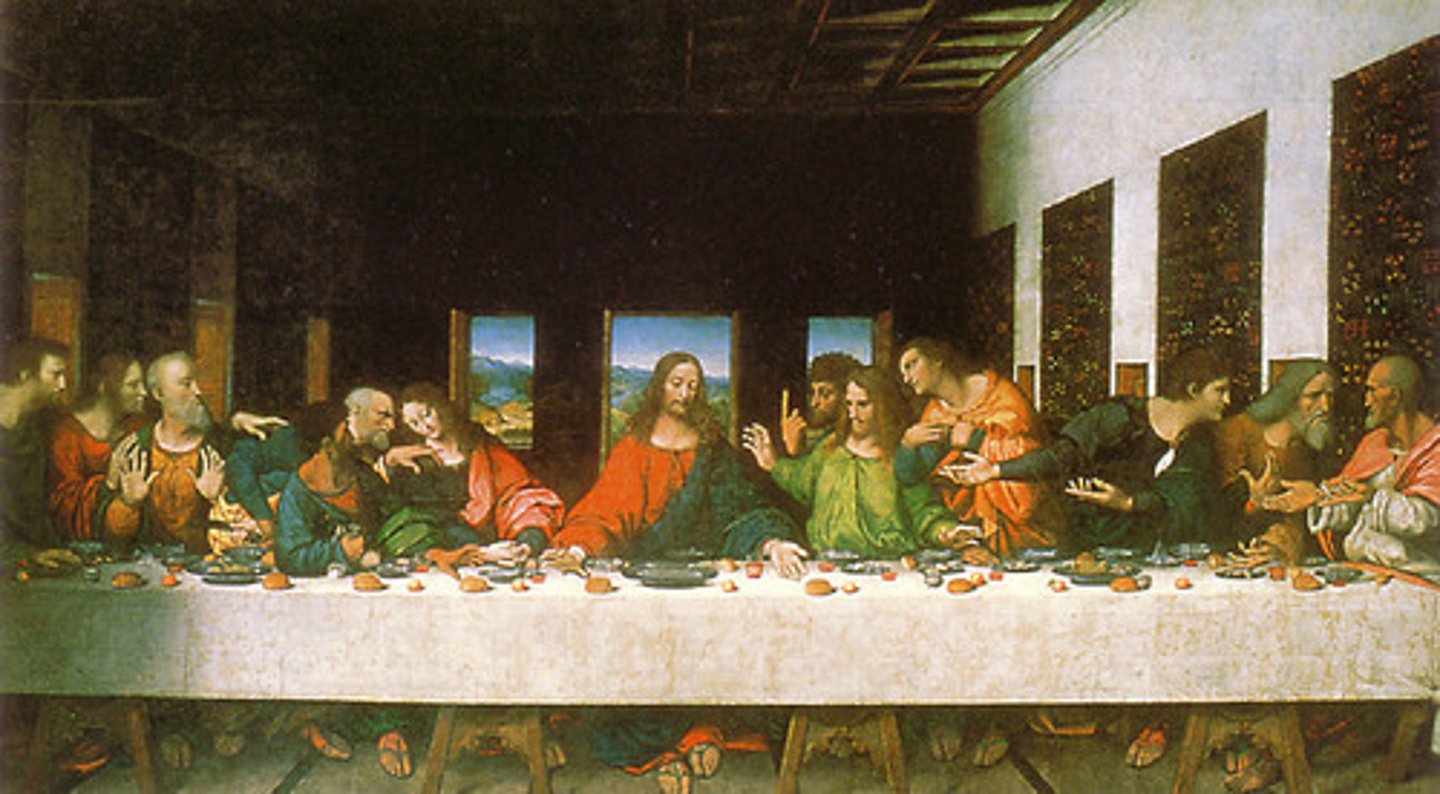
Mona Lisa
Leonardo Da Vinci, 1502 AD
in Paris, France, supposed to show a "man and the intention of his soul", smile in the mouth and eyes, eyes face left and mouth faces right to make her seem like she's always looking, background mimics her (veiled in mist-veil on her head, curves of path-curves of her clothes/arms, split background-her split gaze)
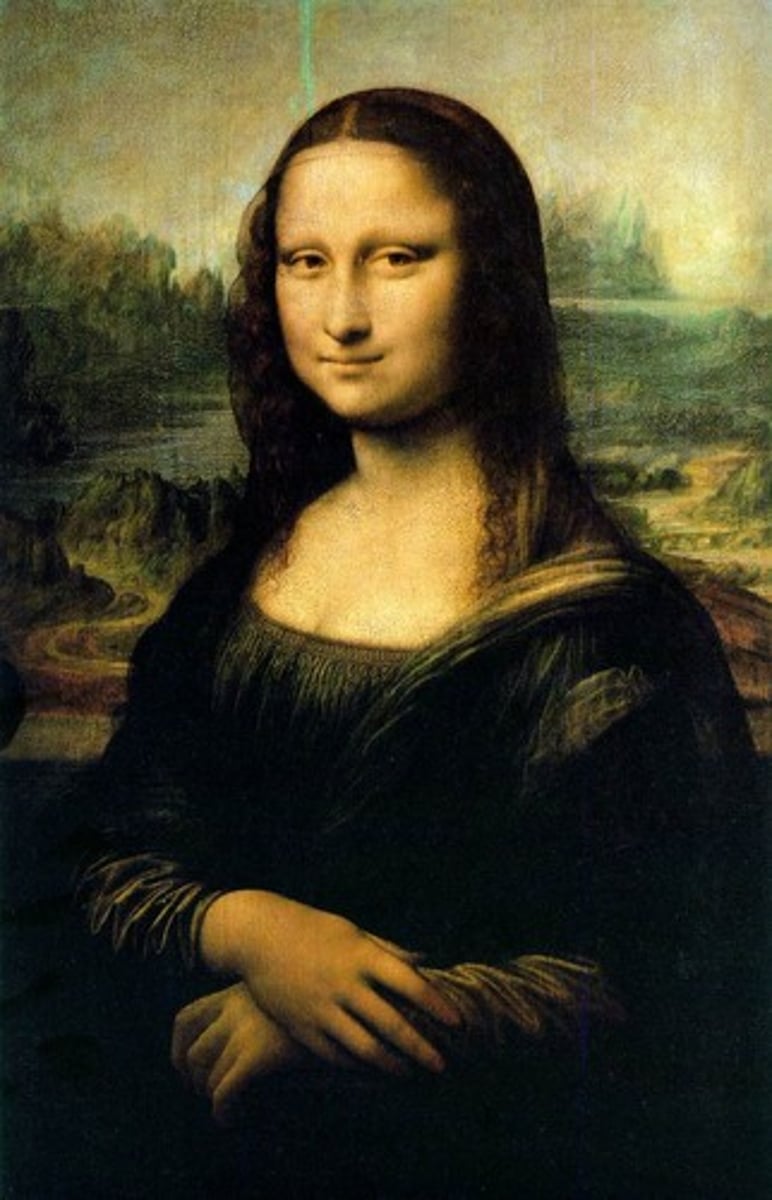
Sistine Chapel
Michelangelo, 1508-1512 AD
131 ft long and over 12,000 square feet of ceiling, broke the circular ceiling with painted/fake pillars, 9 scenes from the OT down the center, OT prophets around the edges of the 9 panels with sybils between, base surrounding it is the genealogy of Christ, (wall panels by other artists like Raphael)
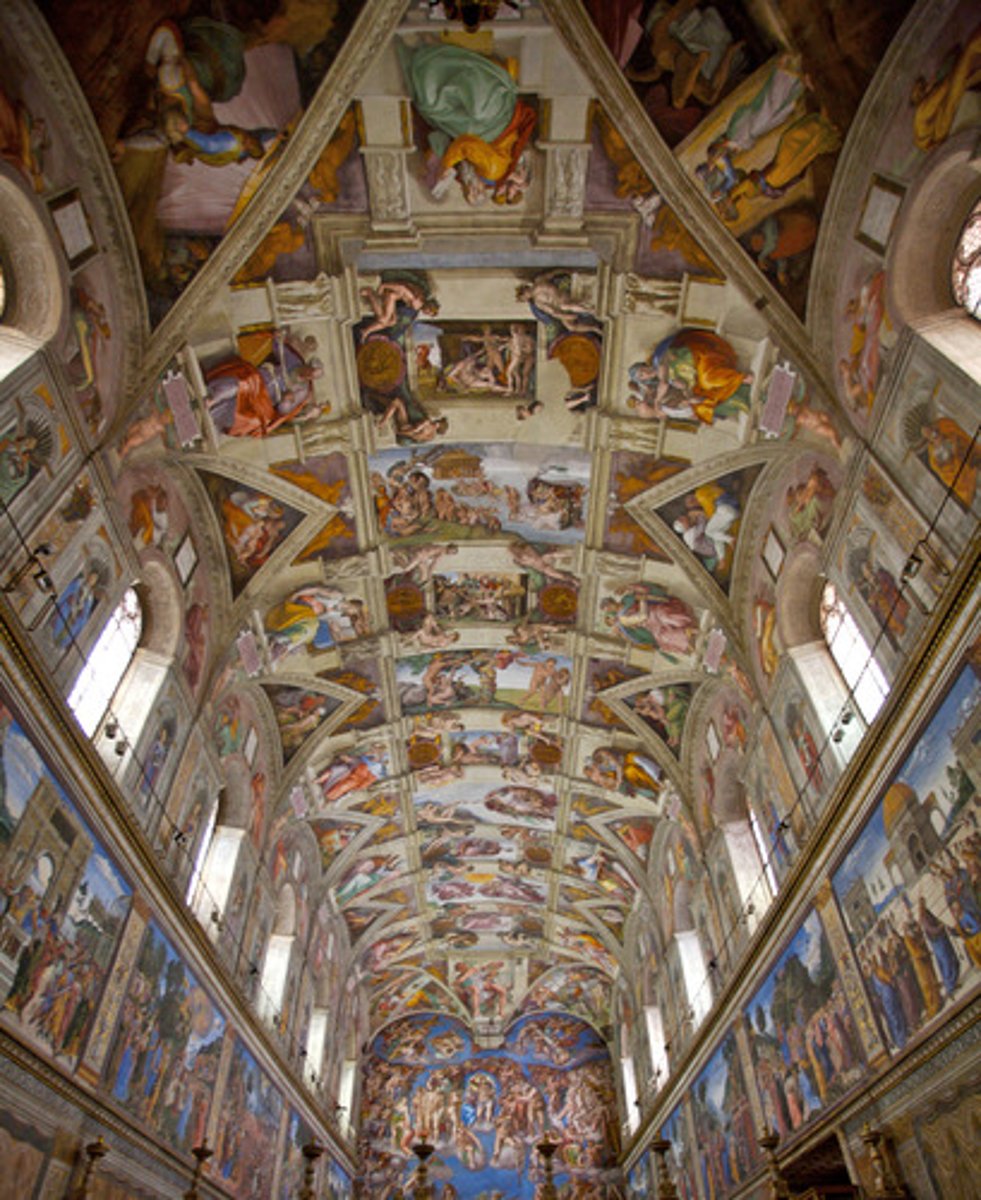
Creation of Adam
dust with the breath of life, God can't get his hands dirt and so fingers don't touch, Adam raises to meet God farther than halfway, God is an older version of Adam, Eve is behind God because God had her in mind to complete the full image of Himself, humanistic interpretation of Scripture

How did Michelangelo paint the Sistine Chapel?
"not" a painter but a sculptor, commissioned to do the Pope Julius II tomb until a change of mind, fled from project commissioned by the pope until a declaration of war on Florence (his escape)
Madonna in the Meadow
Raphael, 1505-1506 AD
Mary is Raphael's feminine ideal, PERFECT, stable perfect triangle between 3 figures, Mary looks at John and holds Jesus, John hands Jesus the cross of his humanity
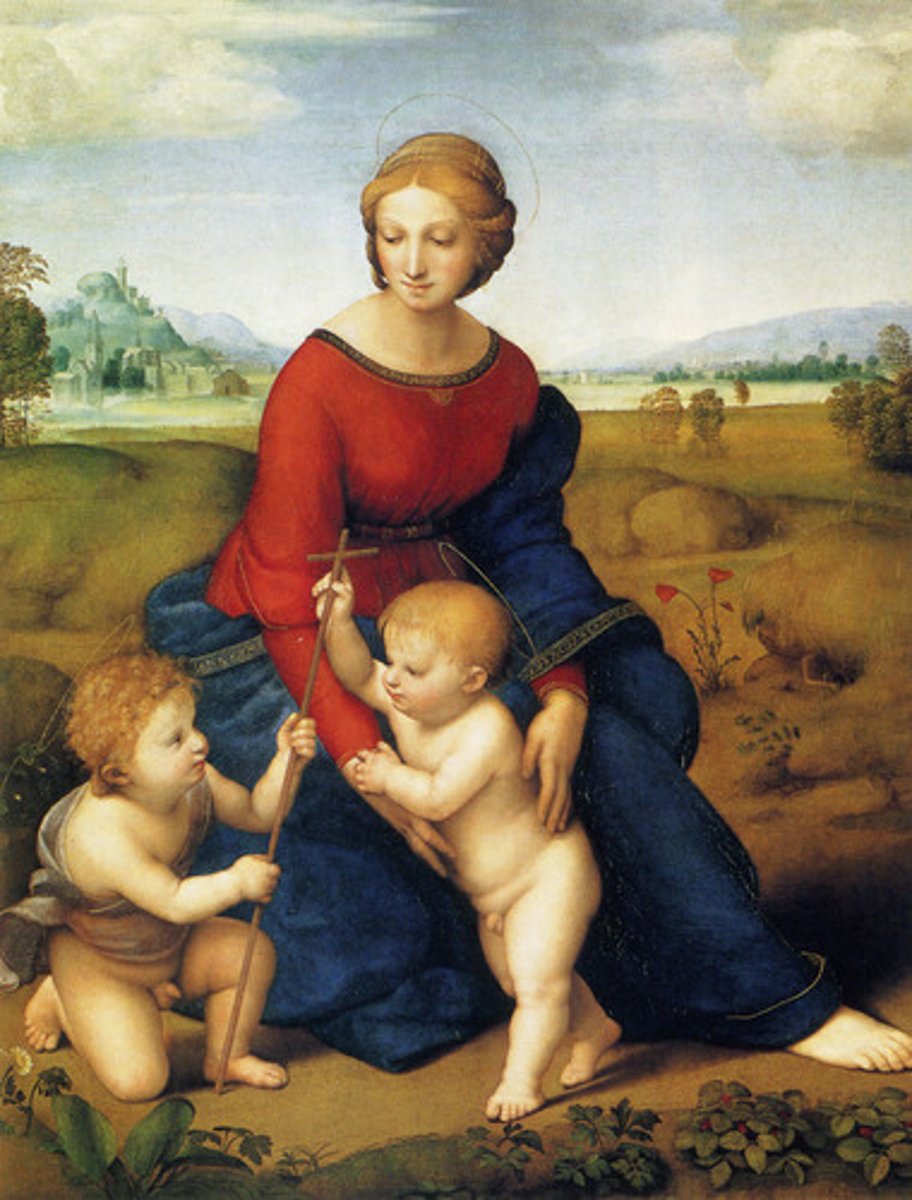
The Nymph Galatea
Raphael, 1512-1514 AD
diverse movements by Galatea is the focus, ditched the expected portrayal of beauty and did his imagined regular beauty (not based on a model, just his imagination)
High Renaissance art in Northern Germany/Netherlands
High Renaissance art in Northern Germany/Netherlands
Crucifixion
Matthias Grunewald, 1515 AD
in Colman, Germany, made for the chapel of a hospital (Isenheim Altarpiece) to remind the patients of the suffering of their high priest
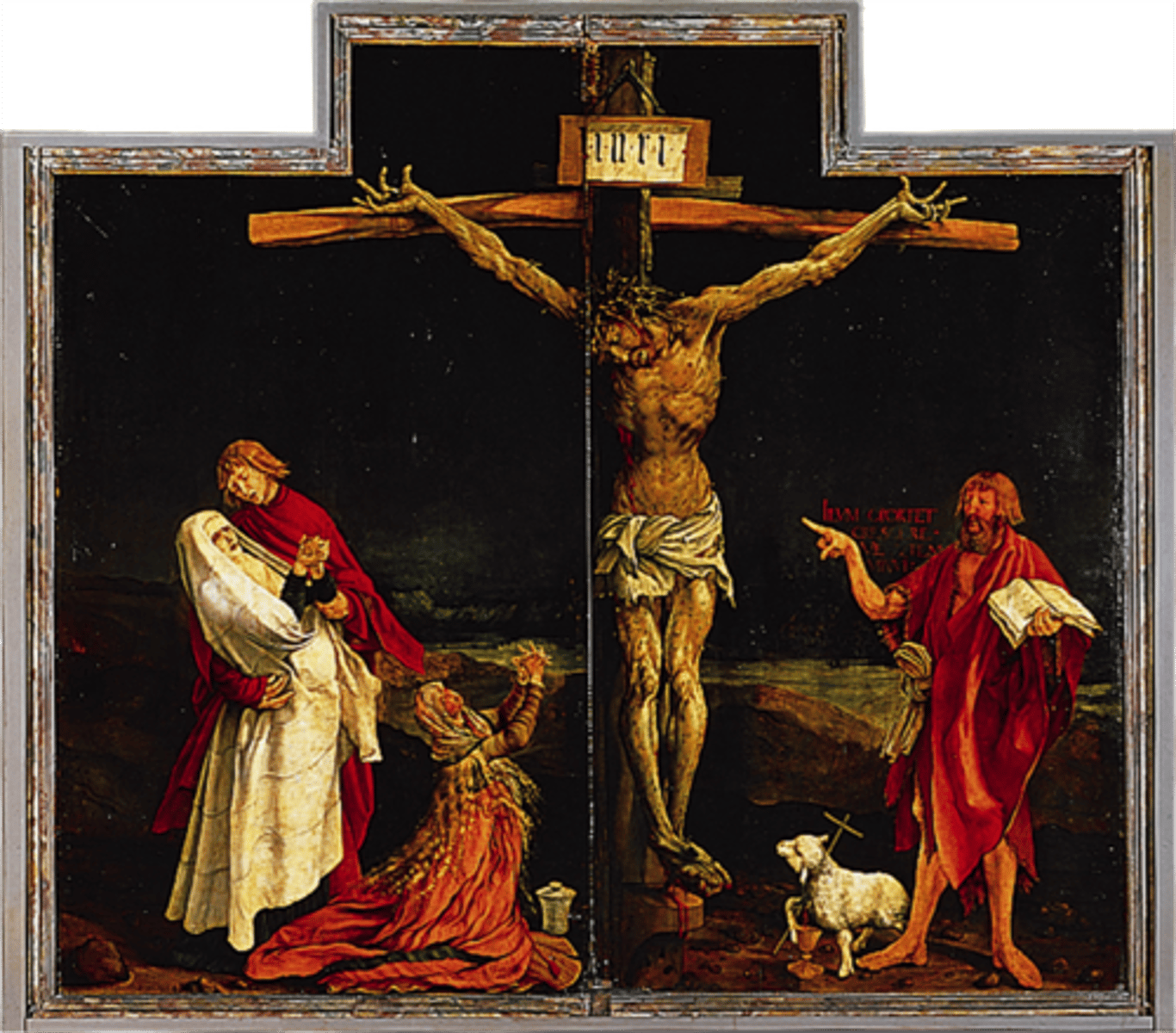
Crucifixion inside by Grunewald
exaltation
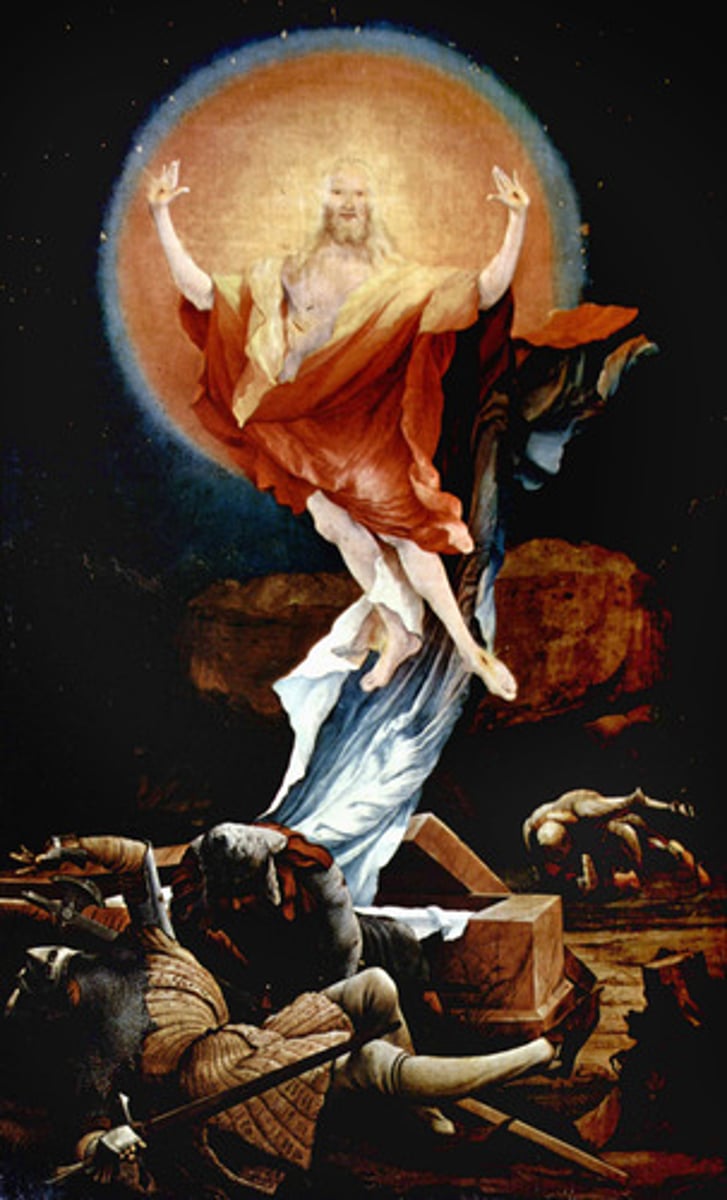
The Nativity
Albrecht Durer, 1504 AD
7 in, making great art portable, small space with intricate/meaningful details, dilapidated buildings, linear perspective to look down at Jesus, first artist to use Florentine/Italian ideas
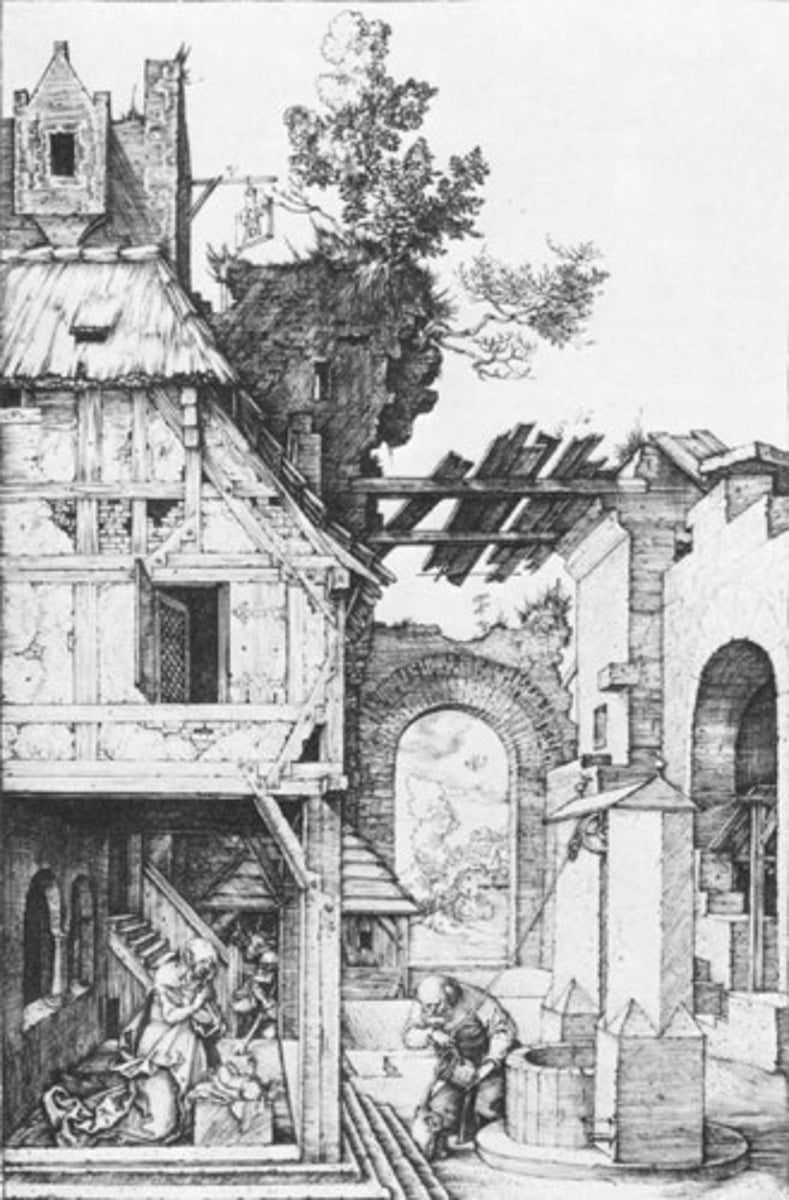
Adam and Eve
Albrecht Durer, 1504 AD
10 in, balanced humors in the forms of animals soon to be disrupted (cat going to eat mouse), trying to do Italian ideas of contrapposto
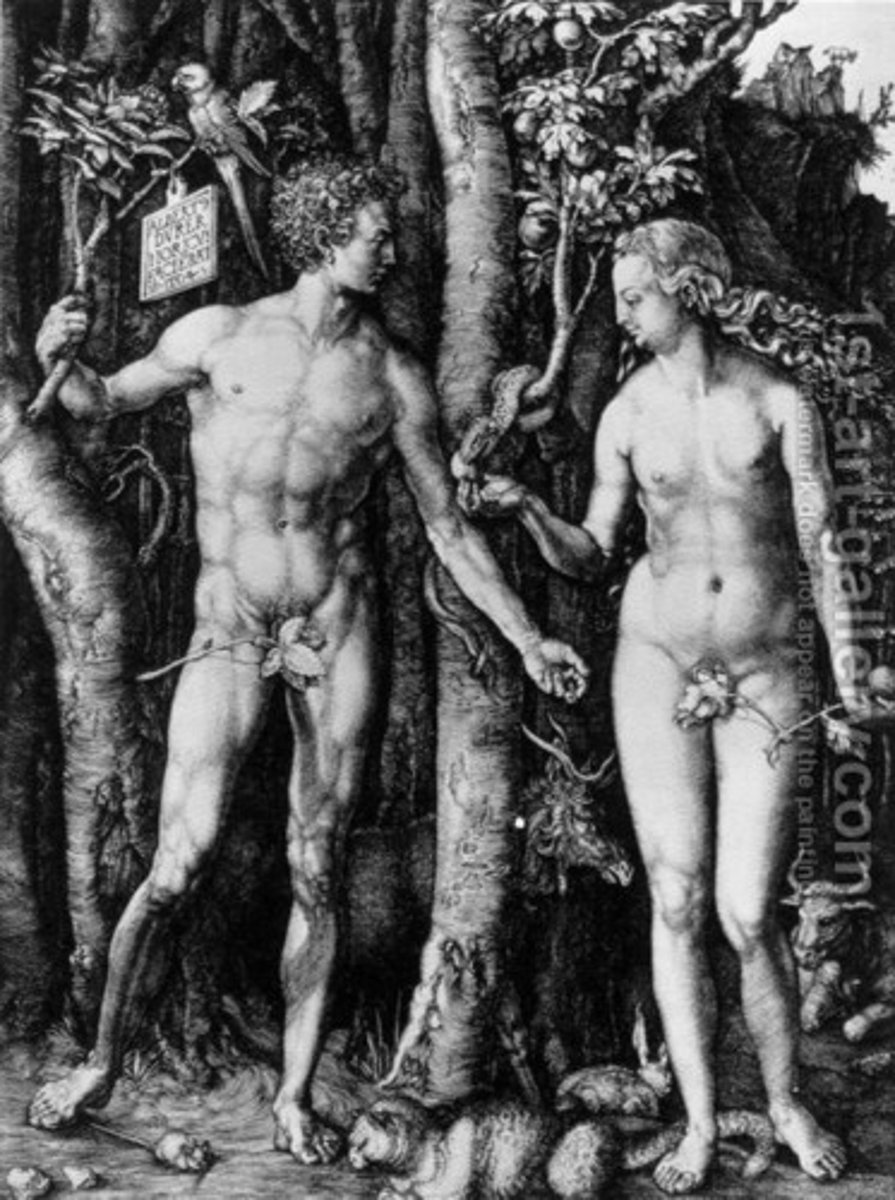
Danube Landscape near Regensburg
Altdorfer, 1526-1528 AD
1st landscape, turning point for art!!!
